-
 Iron tsuba of slightly elongated round form decorated with three pairs of snowflake-form small perforations (ko-sukashi), each outlined with brass wire; five concentric circular rows of dots inlaid in brass or copper ten-zōgan (some dots are missing). Hitsu-ana of oval form. Ōnin school. Unsigned. Late Muromachi period. Dimensions: 75.6 mm x74.6 mm x 3.0 mm. Weight: 78.0 g. Old NBTHK certificate (green paper): Tokubetsu Kicho - "Extraordinary Work". Unlike most Ōnin ten-zōgan tsuba this one does not have circular brass wire inlay inside the dots area; neither it has brass trim around seppa-dai or hitsu-ana.
Iron tsuba of slightly elongated round form decorated with three pairs of snowflake-form small perforations (ko-sukashi), each outlined with brass wire; five concentric circular rows of dots inlaid in brass or copper ten-zōgan (some dots are missing). Hitsu-ana of oval form. Ōnin school. Unsigned. Late Muromachi period. Dimensions: 75.6 mm x74.6 mm x 3.0 mm. Weight: 78.0 g. Old NBTHK certificate (green paper): Tokubetsu Kicho - "Extraordinary Work". Unlike most Ōnin ten-zōgan tsuba this one does not have circular brass wire inlay inside the dots area; neither it has brass trim around seppa-dai or hitsu-ana. -
 Two ymagane tsuba (daisho) with chiseled diaper pattern of waves. The larger tsuba (dai) is of mokkō form with a wide (4.6 mm) polished rim (fukurin?). Water spray is realized in copper ten-zōgan. Size: 75.0 x 71.6 x 3.2 (center), 4.0 (rim) mm. Copper sekigane. The smaller tsuba (sho) is of oval form, without a rim. No inlay. Size: 53.2 x 45.5 x 4.1 mm. Ko-kinko school. Muromachi period. In Kokusai Tosogu Kai; 5th International Convention & Exhibition, 2009 on page 51 under № 5-U8 there is a piece from George Gaucys collection, described as follows: Unsigned Tachi-Kanagushi tsuba, Yamagane base. Nami (wave) motif. Circa: Muromachi period (15th century). 6.88 x 6.81 x 0.45 (rim), 0.36 (center). The classic wave form is typically seen in Muromachi period tosogu. The patina is rich and rustic, which presents history and warmth. This tsuba may be interpreted as either tachi-kanagushi or ko-kinko work. Early tachi tsuba were symmetrical in design and also not very sophisticated, Design elements filled in up to seppadai as the waves do in this tsuba. There is a simple fikurin of the same metal and it is flat to the plate. On the ko-kinko side, the crests of the waves show more complexity than tachi works and less symmetry. A very intriguing tsuba from late Muromachi period."
Two ymagane tsuba (daisho) with chiseled diaper pattern of waves. The larger tsuba (dai) is of mokkō form with a wide (4.6 mm) polished rim (fukurin?). Water spray is realized in copper ten-zōgan. Size: 75.0 x 71.6 x 3.2 (center), 4.0 (rim) mm. Copper sekigane. The smaller tsuba (sho) is of oval form, without a rim. No inlay. Size: 53.2 x 45.5 x 4.1 mm. Ko-kinko school. Muromachi period. In Kokusai Tosogu Kai; 5th International Convention & Exhibition, 2009 on page 51 under № 5-U8 there is a piece from George Gaucys collection, described as follows: Unsigned Tachi-Kanagushi tsuba, Yamagane base. Nami (wave) motif. Circa: Muromachi period (15th century). 6.88 x 6.81 x 0.45 (rim), 0.36 (center). The classic wave form is typically seen in Muromachi period tosogu. The patina is rich and rustic, which presents history and warmth. This tsuba may be interpreted as either tachi-kanagushi or ko-kinko work. Early tachi tsuba were symmetrical in design and also not very sophisticated, Design elements filled in up to seppadai as the waves do in this tsuba. There is a simple fikurin of the same metal and it is flat to the plate. On the ko-kinko side, the crests of the waves show more complexity than tachi works and less symmetry. A very intriguing tsuba from late Muromachi period."
Kokusai Tosogu Kai 5th, 2009, p. 51, № 5-U8: ko-kinko or tachi-kanagushi tsuba.
-
 Ko-kinko ymagane cast tsuba of mokko form (kirikomi-mokkō-gata) with chiseled diaper pattern of double head waves on both sides and a rabbit cast and carved with its eye inlaid in yellow metal (gold or brass) on the face. Fukurin which holds together the sandwiched layers of metal (sanmai) is about 2.4 mm wide. A look-a-like tsub of oval form instead of mokko-gata is illustrated at Robert E. Haynes's Catalog #3,1982 on page 11, lot 15: "Rare design in style of Sanmai (three layers) / Wasei work. With yamagane core and heavy rim cover. The web plates are carved with double head Goto style waves and the face has a fox. The web plates were riveted at the seppadai. See Lot 4, page 8. Ca. 1350. Ht. 6.6 cm, th. 3 mm" [underscore mine]. Quality of photo is so poor that I decided not to provide it here. Muromachi (if we follow Robert) or Momoyama period. The Momoyama attribution is mostly based on a fact that "waves and rabbit" motif became most popular in Momoyama times. Size: 68.5 x 59.8 x 4.0 mm. NBTHK Certificate № 423120. This tsuba is listed at Yakiba website with the following passage: "Attributions as well as dating of this type of tsuba has been the subject debate over the years. There are those who believe these type of tsuba to be ko-Mino (early Mino School) tsuba, others believe them to be tachi-kanaguchi tsuba. Still others insist they are simply ko-kinko (early soft metal) tsuba. This tsuba was authenticated and determined to be "Ko-Kinko" by the NBTHK". Oval form tsuba with the same design can be found in this collection - TSU-0323.
Ko-kinko ymagane cast tsuba of mokko form (kirikomi-mokkō-gata) with chiseled diaper pattern of double head waves on both sides and a rabbit cast and carved with its eye inlaid in yellow metal (gold or brass) on the face. Fukurin which holds together the sandwiched layers of metal (sanmai) is about 2.4 mm wide. A look-a-like tsub of oval form instead of mokko-gata is illustrated at Robert E. Haynes's Catalog #3,1982 on page 11, lot 15: "Rare design in style of Sanmai (three layers) / Wasei work. With yamagane core and heavy rim cover. The web plates are carved with double head Goto style waves and the face has a fox. The web plates were riveted at the seppadai. See Lot 4, page 8. Ca. 1350. Ht. 6.6 cm, th. 3 mm" [underscore mine]. Quality of photo is so poor that I decided not to provide it here. Muromachi (if we follow Robert) or Momoyama period. The Momoyama attribution is mostly based on a fact that "waves and rabbit" motif became most popular in Momoyama times. Size: 68.5 x 59.8 x 4.0 mm. NBTHK Certificate № 423120. This tsuba is listed at Yakiba website with the following passage: "Attributions as well as dating of this type of tsuba has been the subject debate over the years. There are those who believe these type of tsuba to be ko-Mino (early Mino School) tsuba, others believe them to be tachi-kanaguchi tsuba. Still others insist they are simply ko-kinko (early soft metal) tsuba. This tsuba was authenticated and determined to be "Ko-Kinko" by the NBTHK". Oval form tsuba with the same design can be found in this collection - TSU-0323.
TSU-0323. Ko-kinko yamagane tsuba with waves and rabbit motif.
-
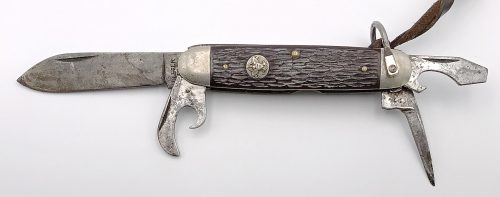
Ulster Official Scout pocket knife with brown jigged bone plastic handles.
Size: 93 mm (closed); 160 mm (opened); 70 mm blade.
Tang is etched with: Ulster -
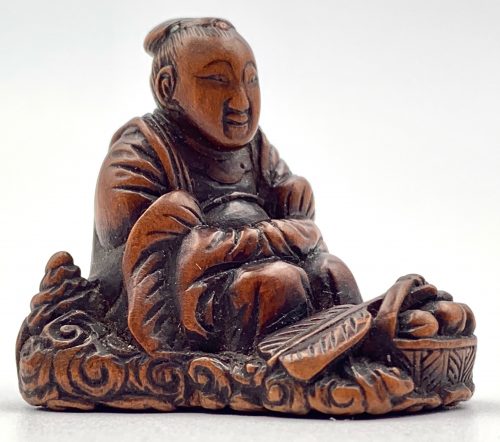 Wood netsuke of Seiōbo with a basket of immortal peaches, seated on a bed of clouds. Carver's signature tablet lost. Circa 1850. Dimensions: 32.6 x 28.1 x 20.1 mm.
Wood netsuke of Seiōbo with a basket of immortal peaches, seated on a bed of clouds. Carver's signature tablet lost. Circa 1850. Dimensions: 32.6 x 28.1 x 20.1 mm.Queen Mother of the West is a calque of Xiwangmu in Chinese sources, Seiōbo in Japan. Peaches of Immortality (Chinese: 仙桃) are consumed by the immortals due to their mystic virtue of conferring longevity on all who eat them.
Provenance: Charles Ephrussi (1849-1905) acquired in the 1870s; a wedding gift in 1898 to his cousin Ritter Viktor von Ephrussi (1860-1945) and Baroness Emilie (Emmy) Schey von Koromla (1879-1938); retrieved post-war by their daughter Elizabeth de Waal (1899-1991); given by her to her brother Ignaz (Iggie) Ephrussi (1906-1994), Tokyo; bequeathed by him to his great-nephew Edmund de Waal (born 1964), London, author of “The Hare with Amber Eyes: a hidden inheritance”. London / New York: Chatto & Windus / Farrar, Straus & Giroux. ISBN 978-0099539551. https://en.wikipedia.org/wiki/Charles_Ephrussi. https://en.wikipedia.org/wiki/Ephrussi_family. https://en.wikipedia.org/wiki/Edmund_de_Waal. -
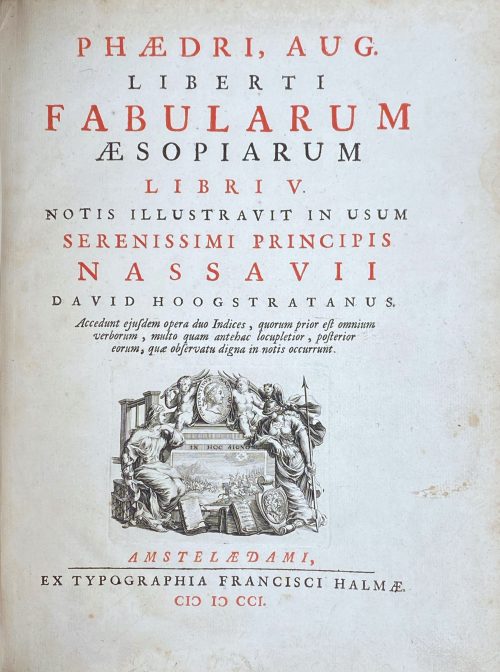 Phaedri, Aug. Liberti Fabularum Aesopiarum libri V / notis illustravit in usum serenissimi principis Nassavii David Hoogstratanus. Accedunt ejusdem opera duo indices, quorum prior est omnium verborum, multo quam antehac locupletior, posterior eorum, quae observatu digna in notis occurunt. — Amstelaedami : Ex Typographia Francisci Halmae, MDCCI [1701]. — pp.: [1] title, [1] (portr.), [32] 160, [84], 18 leaves of plates. Vita Phaedri is written by Johannes Schefferus (February 2, 1621 – March 26, 1679). Appendix fabularum is written by Marquard Gude (Gudius) (1 February 1635 – 26 November 1689). Gaius Julius Phaedrus was a 1st-century CE Roman fabulist and the first versifier of a collection of Aesop's fables into Latin. David van Hoogstraten (Rotterdam, March 14, 1658 - Amsterdam, November 21, 1724), a physician, poet and linguist, annotated the fables and dedicated them to Johan Willem Friso van Oranje-Nassau (14 August 1687 – 14 July 1711). The book was published in Amsterdam by François Halma (Langerak, January 3, 1653 - Leeuwarden, January 13, 1722), a Dutch printer, publisher and bookseller, with a portrait of Prince of Orange-Nassau, engraved by Pieter van Gunst (Dutch, Amsterdam 1659–1724) after Bernard Vaillant (Dutch, Lille 1632–1698 Leyden). The title page was engraved by P. Boutats after Jan Goeree (Dutch, Middelburg 1670–1731 Amsterdam). The edition is adorned throughout with 18 plates, each with 8 médaillons, designed and engraved by Jan van Vianen (Dutch, 1660–1726), and with vignettes, head- and tailpieces, inhabited initials, etc. Contemporary vellum over boards, title in red and back, red edges, 4to, 26 x 20 cm. Seller's description:4to, engraved general title, letterpress red & black title page with allegorical engraved vignette. 18 full-page copper-engraved plates by Jan van Vianen, each featuring six circular images, and 38 in-text reproductions, engraved decorative initials, and head- and tailpieces. Phaedrus (15 BC - 50 AD, Italy), was a "Roman fabulist, the first writer to Latinize whole books of fables, producing free versions in the iambic metre of Greek prose fables then circulating under the name of Aesop." (Ency. Brit.). This deluxe edition was specially created for the Prince of Nassau, profusely illustrated with fine engravings. Dibdin spoke highly of it in his Greek and Latin Classics (4th edition): "I have always considered this as a correct and very sumptuous edition. It is ornamented with a great number of small plates, or medallions, in which the subject of the fable is very ably and spiritedly executed.Ref.: Metropolitan Museum; Musée Médard
Phaedri, Aug. Liberti Fabularum Aesopiarum libri V / notis illustravit in usum serenissimi principis Nassavii David Hoogstratanus. Accedunt ejusdem opera duo indices, quorum prior est omnium verborum, multo quam antehac locupletior, posterior eorum, quae observatu digna in notis occurunt. — Amstelaedami : Ex Typographia Francisci Halmae, MDCCI [1701]. — pp.: [1] title, [1] (portr.), [32] 160, [84], 18 leaves of plates. Vita Phaedri is written by Johannes Schefferus (February 2, 1621 – March 26, 1679). Appendix fabularum is written by Marquard Gude (Gudius) (1 February 1635 – 26 November 1689). Gaius Julius Phaedrus was a 1st-century CE Roman fabulist and the first versifier of a collection of Aesop's fables into Latin. David van Hoogstraten (Rotterdam, March 14, 1658 - Amsterdam, November 21, 1724), a physician, poet and linguist, annotated the fables and dedicated them to Johan Willem Friso van Oranje-Nassau (14 August 1687 – 14 July 1711). The book was published in Amsterdam by François Halma (Langerak, January 3, 1653 - Leeuwarden, January 13, 1722), a Dutch printer, publisher and bookseller, with a portrait of Prince of Orange-Nassau, engraved by Pieter van Gunst (Dutch, Amsterdam 1659–1724) after Bernard Vaillant (Dutch, Lille 1632–1698 Leyden). The title page was engraved by P. Boutats after Jan Goeree (Dutch, Middelburg 1670–1731 Amsterdam). The edition is adorned throughout with 18 plates, each with 8 médaillons, designed and engraved by Jan van Vianen (Dutch, 1660–1726), and with vignettes, head- and tailpieces, inhabited initials, etc. Contemporary vellum over boards, title in red and back, red edges, 4to, 26 x 20 cm. Seller's description:4to, engraved general title, letterpress red & black title page with allegorical engraved vignette. 18 full-page copper-engraved plates by Jan van Vianen, each featuring six circular images, and 38 in-text reproductions, engraved decorative initials, and head- and tailpieces. Phaedrus (15 BC - 50 AD, Italy), was a "Roman fabulist, the first writer to Latinize whole books of fables, producing free versions in the iambic metre of Greek prose fables then circulating under the name of Aesop." (Ency. Brit.). This deluxe edition was specially created for the Prince of Nassau, profusely illustrated with fine engravings. Dibdin spoke highly of it in his Greek and Latin Classics (4th edition): "I have always considered this as a correct and very sumptuous edition. It is ornamented with a great number of small plates, or medallions, in which the subject of the fable is very ably and spiritedly executed.Ref.: Metropolitan Museum; Musée Médard -
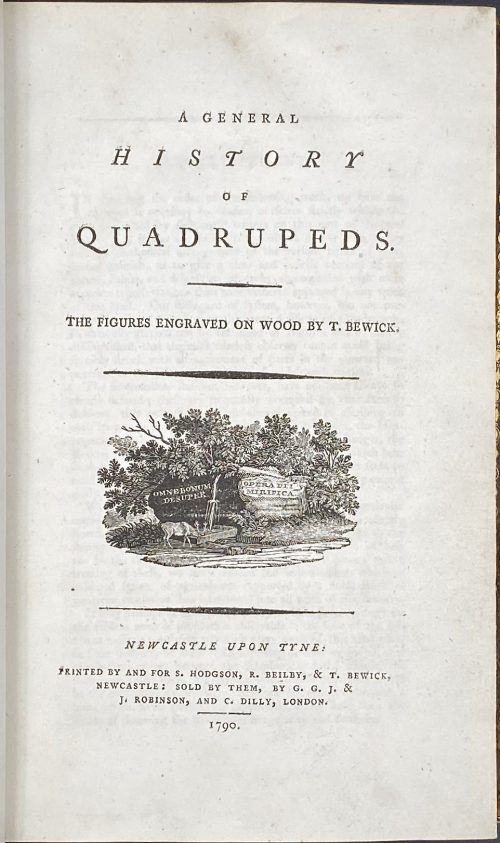 Title: A GENERAL | HISTORY | OF | QUADRUPEDS. | – | THE FIGURES ENGRAVED ON WOOD BY THOMAS BEWICK. | {vignette} | — | NEWCASTLE UPON TYNE : | PRINTED BY AND FOR S. HODGSON, R. BEILBY, & T. BEWICK, | NEWCASTLE: SOLD BY THEM, BY G. G. J. & | J. ROBINSON, AND C. DILLY, LONDON. | 1790. Pagination: [4 blanks], [i, ii] – t.p. / blank, [iii, iv] – advertisement / index, v-viii – index, [1] 2-456 [4 blanks]. Collation: demi 8vo; a⁴ A-Ee⁸ Ff⁴. A3 unsigned, catchword at p.375 THE instead of WE. Variant A (with a fly facing upward). Size: 21.8 x 14 cm; page 21.2 x 13 cm. Woodcuts: 260 descriptions of quadrupeds; 200 figures of quadrupeds, 104 vignettes, tailpieces, etc. Binding: Full marbled calf, gilt double border, black label with gilt lettering to flat spine. There were 1,500 copies Demy copies printed. Catalogue raisonné: S. Roscoe (1953): pp. 5-11; Hugo (1866): pp. 22-23.
Title: A GENERAL | HISTORY | OF | QUADRUPEDS. | – | THE FIGURES ENGRAVED ON WOOD BY THOMAS BEWICK. | {vignette} | — | NEWCASTLE UPON TYNE : | PRINTED BY AND FOR S. HODGSON, R. BEILBY, & T. BEWICK, | NEWCASTLE: SOLD BY THEM, BY G. G. J. & | J. ROBINSON, AND C. DILLY, LONDON. | 1790. Pagination: [4 blanks], [i, ii] – t.p. / blank, [iii, iv] – advertisement / index, v-viii – index, [1] 2-456 [4 blanks]. Collation: demi 8vo; a⁴ A-Ee⁸ Ff⁴. A3 unsigned, catchword at p.375 THE instead of WE. Variant A (with a fly facing upward). Size: 21.8 x 14 cm; page 21.2 x 13 cm. Woodcuts: 260 descriptions of quadrupeds; 200 figures of quadrupeds, 104 vignettes, tailpieces, etc. Binding: Full marbled calf, gilt double border, black label with gilt lettering to flat spine. There were 1,500 copies Demy copies printed. Catalogue raisonné: S. Roscoe (1953): pp. 5-11; Hugo (1866): pp. 22-23. -
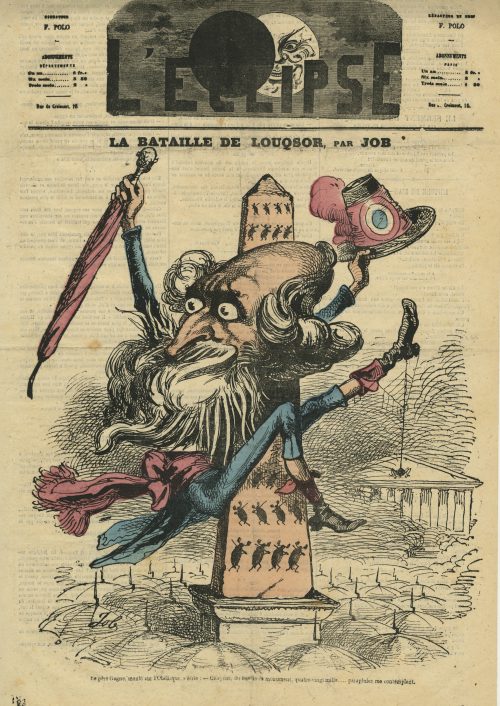 L'Éclipse : journal hebdomadaire, №94, 07-11-1869. La Bataille de Louqsor, par Job. [The Battle of Louqsor, by Job]. Le père Gagne, monté sur l'Obélisque, s'écrie: — Citoyens, du bas de ce monument, quatre-vingt mille…..parapluies me contemplent. [The father Gagne mounted on the Obelisk, cries out: — Citizens, from the bottom of the monument, eighty thousand….umberellas contemplate me]. Étienne-Paulin Gagne, known as Paulin Gagne (French, 1808 – 1876), holding a hat with a tricolour cockade and umbrella with the head of a devil on its grip straddles the obelisk of Luxor at the centre of the Place de la Concorde with marching scarabs on it. A spider dangles from his heel. In the background is The Palais Bourbon, a meeting place of the French National Assembly. The ground is made out of open umbrellas. Paulin Gagne was a graphomaniac poet, essayist, lawyer, politician, inventor, and eccentric, and a perpetual candidate for the Assembly. Ref.: Gallica; Bibliothèque nationale de France, département Philosophie, histoire, sciences de l'homme, FOL-LC13-114
L'Éclipse : journal hebdomadaire, №94, 07-11-1869. La Bataille de Louqsor, par Job. [The Battle of Louqsor, by Job]. Le père Gagne, monté sur l'Obélisque, s'écrie: — Citoyens, du bas de ce monument, quatre-vingt mille…..parapluies me contemplent. [The father Gagne mounted on the Obelisk, cries out: — Citizens, from the bottom of the monument, eighty thousand….umberellas contemplate me]. Étienne-Paulin Gagne, known as Paulin Gagne (French, 1808 – 1876), holding a hat with a tricolour cockade and umbrella with the head of a devil on its grip straddles the obelisk of Luxor at the centre of the Place de la Concorde with marching scarabs on it. A spider dangles from his heel. In the background is The Palais Bourbon, a meeting place of the French National Assembly. The ground is made out of open umbrellas. Paulin Gagne was a graphomaniac poet, essayist, lawyer, politician, inventor, and eccentric, and a perpetual candidate for the Assembly. Ref.: Gallica; Bibliothèque nationale de France, département Philosophie, histoire, sciences de l'homme, FOL-LC13-114 -
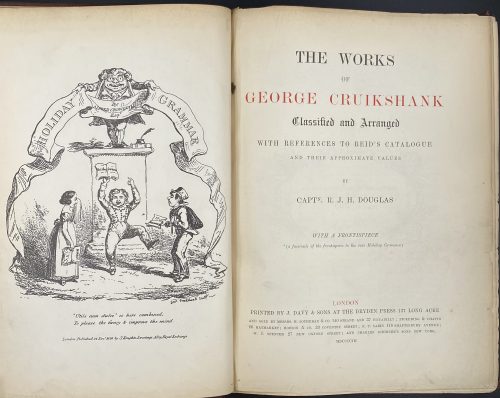 Half-title: THE WORKS | OF | GEORGE CRUIKSHANK | CLASSIFIED AND ARRANGED.|| Title: (in black and red) THE WORKS | OF | GEORGE CRUIKSHANK | CLASSIFIED AND ARRANGED | WITH REFERENCES TO REID'S CATALOGUE | AND THEIR APPROXIMATE VALUES| BY | CAPTN. R. J. H. DOUGLAS | WITH A FRONTISPIECE | (a facsimile of the frontispiece to the rare Holiday Grammar) | LONDON | PRINTED BY J. DAVY & SONS AT THE DRYDEN PRESS 137 LONG ACRE | AND SOLD BY MESSRS. H. SOTHERAN & CO. 140 STRAND AND 37 PICADILLY ; PICKERING & CATTO | 66 HAYMARKET ; ROBSON & CO 23 COVENTRY STREET ; F. T. SABIN 118 SHAFTESBURY AVENUE ; | W. T. SPENSER 27 NEW OXFORD STREET ; AND CHARLES SCRIBNER’S SONS NEW YORK. | MDCCCCIII || Imprint (title verso): One Thousand Copies of this book have been printed and the type distributed. This is No. 205. Bookplate to recto ffl: Reference Library of Francis Edwards Ltd. Not for sale. Inscription to recto ffl: “With the author’s compliments”. Pagination: ffl, [i, ii] – h.t. / blank, [2] – blank / frontis., [iii, iv] – t.p. (black and red) / Print run, [v] v-vi –preface, [2] – contents, [2] – f.t. / note; [1] 2-301 [302] – colophon; insert one sheet with type writing on Francis Edwards letterhead, bfl. (OCLC: ix, 302 pages : illustrations ; 26 cm) Collation: [A]5 B-T8 U7 Binding: Hardcover, burgundy cloth gilt-stamped with title and publisher’s device to front board and gilt lettering to spine.
Half-title: THE WORKS | OF | GEORGE CRUIKSHANK | CLASSIFIED AND ARRANGED.|| Title: (in black and red) THE WORKS | OF | GEORGE CRUIKSHANK | CLASSIFIED AND ARRANGED | WITH REFERENCES TO REID'S CATALOGUE | AND THEIR APPROXIMATE VALUES| BY | CAPTN. R. J. H. DOUGLAS | WITH A FRONTISPIECE | (a facsimile of the frontispiece to the rare Holiday Grammar) | LONDON | PRINTED BY J. DAVY & SONS AT THE DRYDEN PRESS 137 LONG ACRE | AND SOLD BY MESSRS. H. SOTHERAN & CO. 140 STRAND AND 37 PICADILLY ; PICKERING & CATTO | 66 HAYMARKET ; ROBSON & CO 23 COVENTRY STREET ; F. T. SABIN 118 SHAFTESBURY AVENUE ; | W. T. SPENSER 27 NEW OXFORD STREET ; AND CHARLES SCRIBNER’S SONS NEW YORK. | MDCCCCIII || Imprint (title verso): One Thousand Copies of this book have been printed and the type distributed. This is No. 205. Bookplate to recto ffl: Reference Library of Francis Edwards Ltd. Not for sale. Inscription to recto ffl: “With the author’s compliments”. Pagination: ffl, [i, ii] – h.t. / blank, [2] – blank / frontis., [iii, iv] – t.p. (black and red) / Print run, [v] v-vi –preface, [2] – contents, [2] – f.t. / note; [1] 2-301 [302] – colophon; insert one sheet with type writing on Francis Edwards letterhead, bfl. (OCLC: ix, 302 pages : illustrations ; 26 cm) Collation: [A]5 B-T8 U7 Binding: Hardcover, burgundy cloth gilt-stamped with title and publisher’s device to front board and gilt lettering to spine. -
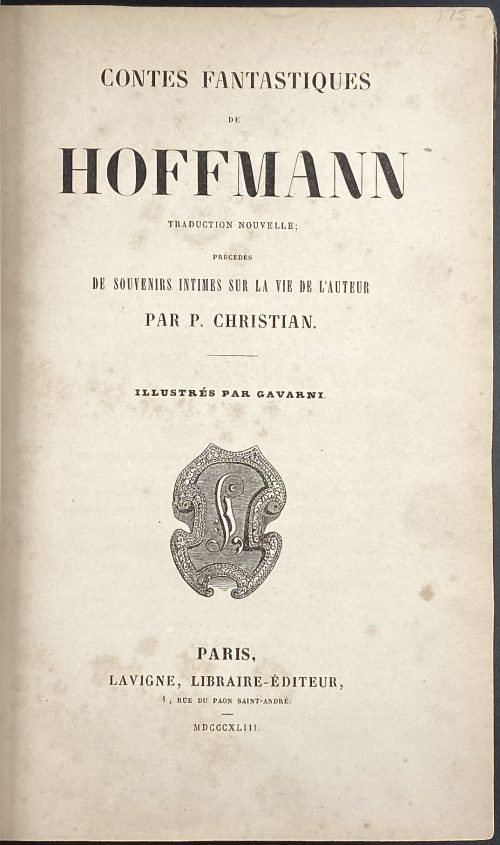 Title: CONTES FANTASTIQUES | DE | HOFFMANN | TRADUCTION NOUVELLE ; PRÉCÉDÉS | DE SOUVENIRS INTIMES SUR LA VIE DE L’AUTEUR | PAR P. CHRISTIAN. | ILLUSTRÉS PAR GAVARNI. | {Publisher’s device} | — PARIS, | LAVIGNE, LIBRAIRE-ÉDITEUR, | 1 RUE DU PAON SAINT-ANDRÉ. | MDCCCXLIII. || Pagination: ffl, [i-vi] –h.t. / colopon, t.p. /blank, dedication /blank, [vii] viii-xix [xx][1,-3] 4-522, bfl, + woodcut illustrations by Brévière et Novionafter Gavarni: 10 full page plates, initials, tail pieces, and in text. Collation: [a]-b4 c2, 1-654 661. Binding: Quarter brown morocco over marbled boards, raised bands with gilt double fillets, gilt arabesque in compartments, title lettering. Catalogue raisonné: L. Carteret (1927), p. 295.
Title: CONTES FANTASTIQUES | DE | HOFFMANN | TRADUCTION NOUVELLE ; PRÉCÉDÉS | DE SOUVENIRS INTIMES SUR LA VIE DE L’AUTEUR | PAR P. CHRISTIAN. | ILLUSTRÉS PAR GAVARNI. | {Publisher’s device} | — PARIS, | LAVIGNE, LIBRAIRE-ÉDITEUR, | 1 RUE DU PAON SAINT-ANDRÉ. | MDCCCXLIII. || Pagination: ffl, [i-vi] –h.t. / colopon, t.p. /blank, dedication /blank, [vii] viii-xix [xx][1,-3] 4-522, bfl, + woodcut illustrations by Brévière et Novionafter Gavarni: 10 full page plates, initials, tail pieces, and in text. Collation: [a]-b4 c2, 1-654 661. Binding: Quarter brown morocco over marbled boards, raised bands with gilt double fillets, gilt arabesque in compartments, title lettering. Catalogue raisonné: L. Carteret (1927), p. 295. -
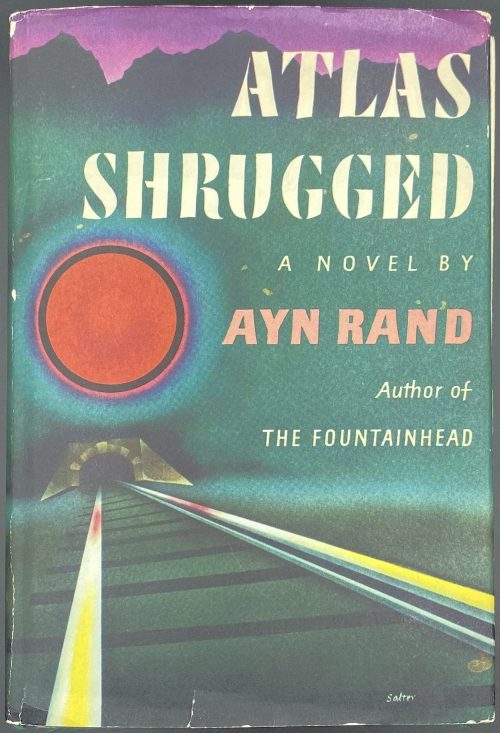 ATLAS | SHRUGGED | AYN RAND | {Publisher's device} | RANDOM HOUSE | NEW YORK || Pagination: [2] - h.t. / advert., [2] – t.p. / colophon, [2] – dedication / blank, [2] – contents / cont., [1, 2] ¬ f.t. / blank, [3] 4-1168 [1169] blank, [1170/71] about the author [1172] blank, two blank leaves. Original green cloth with gilt lettering, black label with gilt lettering and publisher device to spine; top margin green, lateral margin untrimmed. Stated first edition, first printing. Original dust jacket with $6.95 printed price and 10/57 code present on the front flap.
ATLAS | SHRUGGED | AYN RAND | {Publisher's device} | RANDOM HOUSE | NEW YORK || Pagination: [2] - h.t. / advert., [2] – t.p. / colophon, [2] – dedication / blank, [2] – contents / cont., [1, 2] ¬ f.t. / blank, [3] 4-1168 [1169] blank, [1170/71] about the author [1172] blank, two blank leaves. Original green cloth with gilt lettering, black label with gilt lettering and publisher device to spine; top margin green, lateral margin untrimmed. Stated first edition, first printing. Original dust jacket with $6.95 printed price and 10/57 code present on the front flap. -
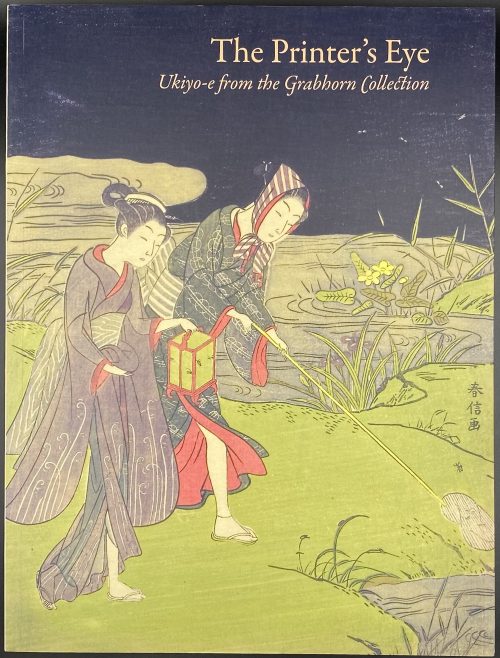 Softcover, pictorial wrappers, pp.: 1-200, il.
Softcover, pictorial wrappers, pp.: 1-200, il.Foreword: A treasure trove of ukiyo-e prints / Kobayashi Tadashi The Grabhorn ukiyo-e collection at the Asian Art Museum / Melissa M. Rinne Edwin Grabhorn : passionate printer and print collector / Julia Meech Figures of humans and animals : some early Japanese color prints from the Grabhorn Collection / David Waterhouse. Edwin Grabhorn (1889—1968), co-founder of the Grabhorn Press, Northern California's premier letterpress printer, was a pioneer American collector of Japanese prints. The Grabhorn prints in the collection of the Asian Art Museum comprise the upper echelons of the original collection. The collection includes a superb selection of early monochrome and hand-colored ukiyo-e prints by Sugimura Jihei, Torii Kiyonobu, Okumura Masanobu and others, from the seminal decades of the woodblock print production in the late 1600s and early 1700s.
-
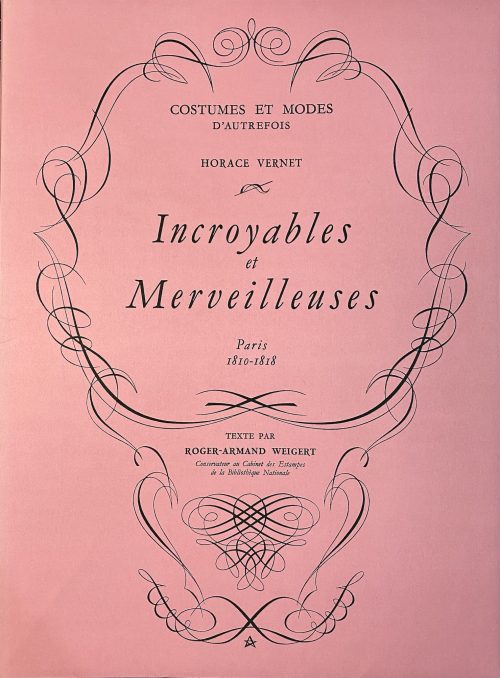 Title: COSTUMES ET MODES | D’AUTREFOIS | HORACE VERNET | Incroyables | et | Merveilleuses | Paris | 1810–1818 | TEXTE PAR | ROGER–ARMAND WEIGERT | Conservateur au Cabinet des Estampes | de la Bibliothèque Nationale | ÉDITIONS ROMBALDI | PARIS || Content: 24 photomechanical reproductions of the images from Bibliothèque nationale de France, printed on vélin paper from Papeteries Aussedat by Papeteries de la Moselle printing presses and stencil-coloured by Edmond Vairel. Text printed by Imprimerie Kapp on October 20, 1955. A print run of 4,000 copies, of which this is №122. Exterior: Pink lettered dust jacket over wrappers. Pagination: loose double leaves, [4 blanks] [4 h.t. and t.p.], i-xi [xii], 24 unnumbered plates, [4 blanks].
Title: COSTUMES ET MODES | D’AUTREFOIS | HORACE VERNET | Incroyables | et | Merveilleuses | Paris | 1810–1818 | TEXTE PAR | ROGER–ARMAND WEIGERT | Conservateur au Cabinet des Estampes | de la Bibliothèque Nationale | ÉDITIONS ROMBALDI | PARIS || Content: 24 photomechanical reproductions of the images from Bibliothèque nationale de France, printed on vélin paper from Papeteries Aussedat by Papeteries de la Moselle printing presses and stencil-coloured by Edmond Vairel. Text printed by Imprimerie Kapp on October 20, 1955. A print run of 4,000 copies, of which this is №122. Exterior: Pink lettered dust jacket over wrappers. Pagination: loose double leaves, [4 blanks] [4 h.t. and t.p.], i-xi [xii], 24 unnumbered plates, [4 blanks].Weigert, Roger-Armand (French, 1907-1986).
Émile Jean-Horace Vernet [Horace Vernet] (French, 1789 – 1863). Gatine, Georges Jacques (French, 1773 – after 1841). -
![Конрад Н.И. Театр Кабуки, его история и теория // Японский театр. — Л.-М.: Academia — Всесоюзное Общество культурной связи с заграницей, 1928. — Тир. 3.200 экз. [Сборник статей под редакцией проф. Н. И. Конрада. В книге представлены статьи Н. Конрада, О. Плетнера, Д. Аркина, посвященные традиционному японскому театру. Объём книжки — 60 стр.].](https://varshavskycollection.com/wp-content/uploads/2021/02/LIB-0975.2016-a-500x619.jpeg) Title page: ВСЕСОЮЗНОЕ ОБЩЕСТВО КУЛЬТУРНОЙ СВЯЗИ С ЗАГРАНИЦЕЙ | ЯПОНСКИЙ ТЕАТР | СБОРНИК СТАТЕЙ | ПОД РЕДАКЦИЕЙ | ПРОФ. Н. И. КОНРАДА | ЛЕНИНГРАД 1928 МОСКВА || T.p. verso: Отпечатано по заказу Всесоюзного | Общества Культурной Связи с загра- | ницей издательством «ACADEMIA» | Государственного Института Истории | Искусств | Обложка работы | Н. А. И А. А. УШИНЫХ | Лениградский Областлит № 12814 […] Тираж 3200 экз. | 2-я типография Транспечати ГКПС, Ленинград, Улица Правды 15. || Bibliographical description: 21.5 x 17 cm; Publisher’s black pictorial wrappers, front cover with lettering: «ЯПОНСКИЙ ТЕАТР» | ВОКС ||, pp. [2] frontis., [2] t.p. / imprint, [2] h.t. / blank, [9] 10-59 [60] – content; collation: [1]7 2-38 46, (first leaf messing from the first gathering), 4 photo illustrations in collation, back black geometrical wrapper. Contents: Н. И. Конрад. Театр в Японии. Общий очерк. — с. 9. Его же. Театр Кабуки, его история и теория. — с. 15. Ол. Плетнер. Театр Кабуки. Социологический очерк. — с. 31. Д. Е. Аркин. Театр Кабуки. Формы и средства театральной выразительности. – c. 45. Personae: Конрад, Николай Иосифович (Russian, 1891 – 1970). Плетнер, Олег Викторович ( Russian, 1893 – 1929). Аркин, Давид Ефимович (Russian, 1899 – 1957). Ушин, Николай Алексеевич (Russian, 1898 – 1942). Ушин , Алексей Алексеевич (Russian, 1904 – 1942).
Title page: ВСЕСОЮЗНОЕ ОБЩЕСТВО КУЛЬТУРНОЙ СВЯЗИ С ЗАГРАНИЦЕЙ | ЯПОНСКИЙ ТЕАТР | СБОРНИК СТАТЕЙ | ПОД РЕДАКЦИЕЙ | ПРОФ. Н. И. КОНРАДА | ЛЕНИНГРАД 1928 МОСКВА || T.p. verso: Отпечатано по заказу Всесоюзного | Общества Культурной Связи с загра- | ницей издательством «ACADEMIA» | Государственного Института Истории | Искусств | Обложка работы | Н. А. И А. А. УШИНЫХ | Лениградский Областлит № 12814 […] Тираж 3200 экз. | 2-я типография Транспечати ГКПС, Ленинград, Улица Правды 15. || Bibliographical description: 21.5 x 17 cm; Publisher’s black pictorial wrappers, front cover with lettering: «ЯПОНСКИЙ ТЕАТР» | ВОКС ||, pp. [2] frontis., [2] t.p. / imprint, [2] h.t. / blank, [9] 10-59 [60] – content; collation: [1]7 2-38 46, (first leaf messing from the first gathering), 4 photo illustrations in collation, back black geometrical wrapper. Contents: Н. И. Конрад. Театр в Японии. Общий очерк. — с. 9. Его же. Театр Кабуки, его история и теория. — с. 15. Ол. Плетнер. Театр Кабуки. Социологический очерк. — с. 31. Д. Е. Аркин. Театр Кабуки. Формы и средства театральной выразительности. – c. 45. Personae: Конрад, Николай Иосифович (Russian, 1891 – 1970). Плетнер, Олег Викторович ( Russian, 1893 – 1929). Аркин, Давид Ефимович (Russian, 1899 – 1957). Ушин, Николай Алексеевич (Russian, 1898 – 1942). Ушин , Алексей Алексеевич (Russian, 1904 – 1942). -
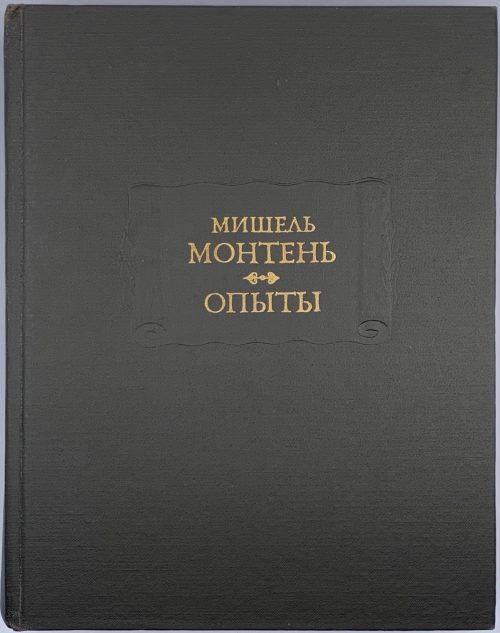 A two-volume edition. 1st vol. Title (in black and red): МИШЕЛЬ | МОНТЕНЬ | ОПЫТЫ | В ТРЕХ КНИГАХ | КНИГИ | ПЕРВАЯ И ВТОРАЯ | Издание подготовили | А. С. БОБОВИЧ | Ф. А. КОГАН-БЕРНШТЕЙН | Н. Я. РЫКОВА, А. А. СМИРНОВ | Второе издание | ИЗДАТЕЛЬСТВО "НАУКА | МОСКВА | 1979 || Opposite title: MICHEL |de | MONTAIGNE | LES ESSAIS || Pagination: [1-5] 6-703 [1], errata slip. Collation: 16mo, [1]-2216, + frontispiece portrait and 2 plates extraneous to collation. 2nd vol. Title (2) (in black and red): МИШЕЛЬ | МОНТЕНЬ | ОПЫТЫ | В ТРЕХ КНИГАХ | КНИГА ТРЕТЬЯ | Издание подготовили | А. С. БОБОВИЧ | Ф. А. КОГАН-БЕРНШТЕЙН | Н. Я. РЫКОВА, А. А. СМИРНОВ | Второе издание | ИЗДАТЕЛЬСТВО "НАУКА | МОСКВА | 1979 || Opposite title: MICHEL |de | MONTAIGNE | LES ESSAIS || Pagination: [1-5] 6-534 [2]. Collation: 8vo, [1]-348, + frontispiece portrait. Binding: Uniformly bound in serial design green cloth with gilt lettering on an embossed scroll to front cover, gilt lettering to spine, 22 x 18 cm. Print run: 200,000 copies each volume. Michel Eyquem de Montaigne (French, 1533 – 1592) Ананий [Анатолий] Самуилович Бобович (Russian-Jewish, 1904 – 1988) Надежда Януарьевна Рыкова (Russian, 1901 – 1996) Александр Александрович Смирнов (Russian, 1883– 1962) Фаина Абрамовна Коган-Бернштейн [b. Аронгауз] (Russian-Jewish, 1899 – 1976)
A two-volume edition. 1st vol. Title (in black and red): МИШЕЛЬ | МОНТЕНЬ | ОПЫТЫ | В ТРЕХ КНИГАХ | КНИГИ | ПЕРВАЯ И ВТОРАЯ | Издание подготовили | А. С. БОБОВИЧ | Ф. А. КОГАН-БЕРНШТЕЙН | Н. Я. РЫКОВА, А. А. СМИРНОВ | Второе издание | ИЗДАТЕЛЬСТВО "НАУКА | МОСКВА | 1979 || Opposite title: MICHEL |de | MONTAIGNE | LES ESSAIS || Pagination: [1-5] 6-703 [1], errata slip. Collation: 16mo, [1]-2216, + frontispiece portrait and 2 plates extraneous to collation. 2nd vol. Title (2) (in black and red): МИШЕЛЬ | МОНТЕНЬ | ОПЫТЫ | В ТРЕХ КНИГАХ | КНИГА ТРЕТЬЯ | Издание подготовили | А. С. БОБОВИЧ | Ф. А. КОГАН-БЕРНШТЕЙН | Н. Я. РЫКОВА, А. А. СМИРНОВ | Второе издание | ИЗДАТЕЛЬСТВО "НАУКА | МОСКВА | 1979 || Opposite title: MICHEL |de | MONTAIGNE | LES ESSAIS || Pagination: [1-5] 6-534 [2]. Collation: 8vo, [1]-348, + frontispiece portrait. Binding: Uniformly bound in serial design green cloth with gilt lettering on an embossed scroll to front cover, gilt lettering to spine, 22 x 18 cm. Print run: 200,000 copies each volume. Michel Eyquem de Montaigne (French, 1533 – 1592) Ананий [Анатолий] Самуилович Бобович (Russian-Jewish, 1904 – 1988) Надежда Януарьевна Рыкова (Russian, 1901 – 1996) Александр Александрович Смирнов (Russian, 1883– 1962) Фаина Абрамовна Коган-Бернштейн [b. Аронгауз] (Russian-Jewish, 1899 – 1976) -
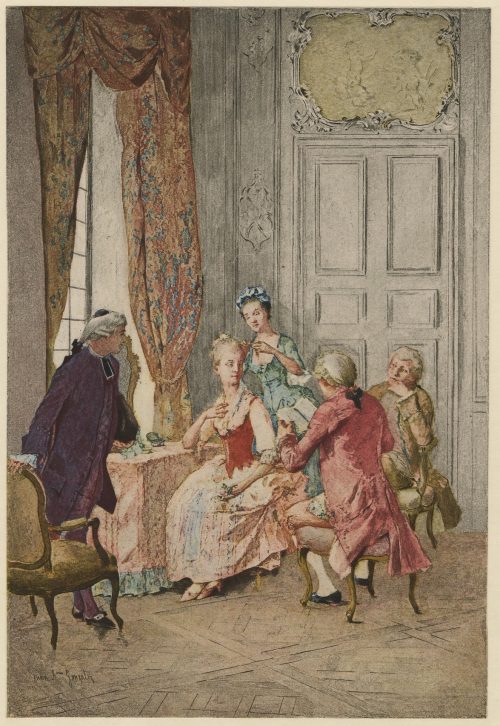
Coloured etching by E. Charreyre (French, fl. 1880 – ?) after a watercolour by Juan Antonio González, (Spanish, 1842 – 1914). A book illustration for 'Son Altesse La Femme' by Octave Uzanne (1851 – 1931), chapter: 'La Caillette' (Le lever d’une petite-maitresse au XVIIIe siècle). Published by Albert Quantin (French, 1850 – 1930) in 1885.
Size: print 17.5 x 12 cm, pasted to leaf 27.7 x 19.5 cm.
-
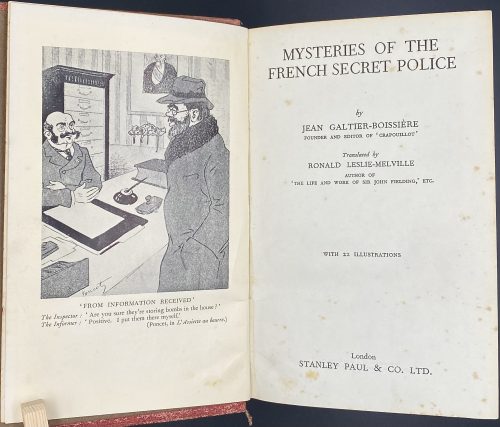 Title page: MYSTERIES OF THE | FRENCH SECRET POLICE | by | JEAN GALTIER-BOISSIÈRE | FOUNDER AND EDITOR OF ‘CRAPOUILLOT’ | Translated by | RONALD LESLIE-MELVILLE | AUTHOR OF | ‘THE LIFE AND WORK OF SIR JOHN FIELDING’, ETC. | WITH 22 ILLUSTRATIONS | London | STANLEY PAUL & CO. LTD. || Pagination: [1-8] 9-292 [16 advert], frontis., 14 pp of ill. Collation: 8vo; [A]8 B-R8 S10 + 8 leaves of advertisement + frontispiece and 7 leaves of b/w photomechanical illustrations. Binding: Burgundy cloth, gilt lettering to spine, brown endpapers. Contributors: Galtier-Boissière, Jean (French, 1891 – 1966) – author. Leslie-Melville, Ronald (British, 1905 – 1942) – translator. Stanley Paul (London) – publisher. Mayflower Press (Plymouth), William Brendon & Son (Plymouth) – printers.
Title page: MYSTERIES OF THE | FRENCH SECRET POLICE | by | JEAN GALTIER-BOISSIÈRE | FOUNDER AND EDITOR OF ‘CRAPOUILLOT’ | Translated by | RONALD LESLIE-MELVILLE | AUTHOR OF | ‘THE LIFE AND WORK OF SIR JOHN FIELDING’, ETC. | WITH 22 ILLUSTRATIONS | London | STANLEY PAUL & CO. LTD. || Pagination: [1-8] 9-292 [16 advert], frontis., 14 pp of ill. Collation: 8vo; [A]8 B-R8 S10 + 8 leaves of advertisement + frontispiece and 7 leaves of b/w photomechanical illustrations. Binding: Burgundy cloth, gilt lettering to spine, brown endpapers. Contributors: Galtier-Boissière, Jean (French, 1891 – 1966) – author. Leslie-Melville, Ronald (British, 1905 – 1942) – translator. Stanley Paul (London) – publisher. Mayflower Press (Plymouth), William Brendon & Son (Plymouth) – printers. -
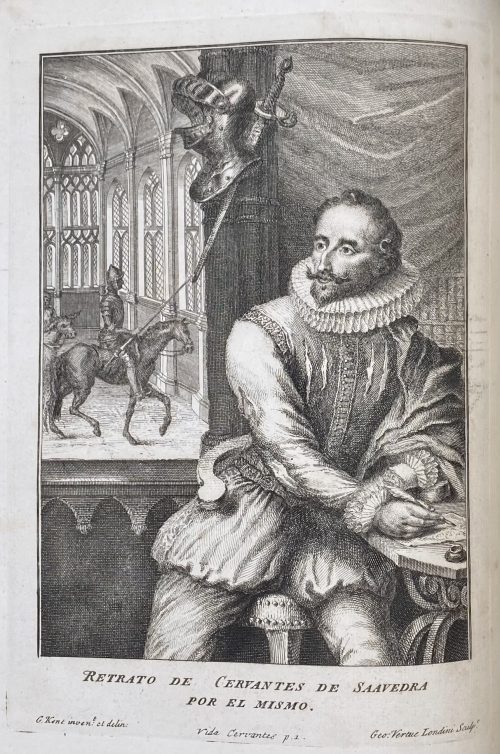 Two volumes uniformly bound by Riviere & Son in full red marbled calf, triple fillet border stamped in gilt, elaborate gilt ornament and brown morocco labels with gilt lettering to spine, all edge gilt, gilt dentelles. Vol. 1: Title page: THE | LIFE AND EXPLOITS | Of the ingenious gentleman | DON QUIXOTE | DE LA MANCHA. | Translated from the Original Spanish of | Miguel Cervantes de Saavedra. | By CHARLES JARVIS, Esq; | IN TWO VOLUMES. | {single rule} | VOLUME the FIRST. | {double rule} | LONDON: | Printed for J. and R. Tonson in the Strand, and | R. Dodsley in Pall-Mall. | {single rule} | M DCC XLII || Pagination: [i-iii] iv-xxxii, [i-iii] iv-vi, [2], [1] 2-90, [14], [1] 2-355 [356]; 500 pages total + ils. Collation: 4to; 250 leaves; A4 a-b4 c-d2, A4, a-l4 m2 n4 o2, B-Z4, Aa-Yy4 Z2, ils. Illustrations: 27 full-page copperplate engravings, incl. frontispiece (skillfully repaired), portrait of Cervantes by George Vertue After G. Kent and a fictional portrait of Don Quixote by George Vertue after John Vanderbank. Vol. 2: Title page: THE | LIFE AND EXPLOITS | Of the ingenious gentleman | DON QUIXOTE | DE LA MANCHA. | Translated from the Original Spanish of | Miguel Cervantes de Saavedra. | By CHARLES JARVIS, Esq; | {single rule} | VOLUME the SECOND. | {double rule} | LONDON: | Printed for J. and R. Tonson in the Strand, and | R. Dodsley in Pall-Mall. | {single rule} | M DCC XLII || Pagination: [i-iii] iv-xii, [1] 2-388; 400 pages total + ils. Collation: 4to; 200 leaves; A4 a2 B-Z4 Aa-Zz4 Aaa-Ccc4 Ddd2, ils. Illustrations:41 full-page copperplate engravings, pl. 29 (as frontispieces) precedes pl. 28. Contributors: Author: Miguel de Cervantes Saavedra (Spanish, 1547 – 1616) Translator: Charles Jervas (British, 1675 – 1739) Author: Cervantes biography by Gregorio Mayans y Siscar (Spanish, 1699 – 1781) Translator: Cervantes biography by John Ozell (British, d. 1743) Illustrator: John Vanderbank, the younger (British, 1694 – 1739) Artist: (Cervantes portrait): G. Kent (British, fl. 1738 – 1742) Engravers: Gerard Vandergucht (British, 1696 – 1776); George Vertue (British, 1684 – 1756); Bernard Baron (French, 1696 – 1762); Claude Du Bosc (French, 1682 – 1746 or later) Publishers: J. and R. Tonson (London); Robert Dodsley (British, 1703 – 1764) Catalogue raisonné: Lewine p. 102 Reference: Metropolitan Museum (New York)
Two volumes uniformly bound by Riviere & Son in full red marbled calf, triple fillet border stamped in gilt, elaborate gilt ornament and brown morocco labels with gilt lettering to spine, all edge gilt, gilt dentelles. Vol. 1: Title page: THE | LIFE AND EXPLOITS | Of the ingenious gentleman | DON QUIXOTE | DE LA MANCHA. | Translated from the Original Spanish of | Miguel Cervantes de Saavedra. | By CHARLES JARVIS, Esq; | IN TWO VOLUMES. | {single rule} | VOLUME the FIRST. | {double rule} | LONDON: | Printed for J. and R. Tonson in the Strand, and | R. Dodsley in Pall-Mall. | {single rule} | M DCC XLII || Pagination: [i-iii] iv-xxxii, [i-iii] iv-vi, [2], [1] 2-90, [14], [1] 2-355 [356]; 500 pages total + ils. Collation: 4to; 250 leaves; A4 a-b4 c-d2, A4, a-l4 m2 n4 o2, B-Z4, Aa-Yy4 Z2, ils. Illustrations: 27 full-page copperplate engravings, incl. frontispiece (skillfully repaired), portrait of Cervantes by George Vertue After G. Kent and a fictional portrait of Don Quixote by George Vertue after John Vanderbank. Vol. 2: Title page: THE | LIFE AND EXPLOITS | Of the ingenious gentleman | DON QUIXOTE | DE LA MANCHA. | Translated from the Original Spanish of | Miguel Cervantes de Saavedra. | By CHARLES JARVIS, Esq; | {single rule} | VOLUME the SECOND. | {double rule} | LONDON: | Printed for J. and R. Tonson in the Strand, and | R. Dodsley in Pall-Mall. | {single rule} | M DCC XLII || Pagination: [i-iii] iv-xii, [1] 2-388; 400 pages total + ils. Collation: 4to; 200 leaves; A4 a2 B-Z4 Aa-Zz4 Aaa-Ccc4 Ddd2, ils. Illustrations:41 full-page copperplate engravings, pl. 29 (as frontispieces) precedes pl. 28. Contributors: Author: Miguel de Cervantes Saavedra (Spanish, 1547 – 1616) Translator: Charles Jervas (British, 1675 – 1739) Author: Cervantes biography by Gregorio Mayans y Siscar (Spanish, 1699 – 1781) Translator: Cervantes biography by John Ozell (British, d. 1743) Illustrator: John Vanderbank, the younger (British, 1694 – 1739) Artist: (Cervantes portrait): G. Kent (British, fl. 1738 – 1742) Engravers: Gerard Vandergucht (British, 1696 – 1776); George Vertue (British, 1684 – 1756); Bernard Baron (French, 1696 – 1762); Claude Du Bosc (French, 1682 – 1746 or later) Publishers: J. and R. Tonson (London); Robert Dodsley (British, 1703 – 1764) Catalogue raisonné: Lewine p. 102 Reference: Metropolitan Museum (New York) -
 Title page: ACROSS THE RIVER | AND | INTO THE TREES | BY | ERNEST HEMINGWAY | CHARLES SCRIBNER'S SONS | NEW YORK | 1950 || Pagination: [12] 1-308; total 160 leaves. Binding: black cloth, gilt Hemingway's fac-simile to front board, lettering to spine, pictorial dust jacket designed by A. Ivancich; $3.00 price clipped from top of front flap. Bookplate of Feodor Rojankovsky to front pastedown. Size: 21.5 x 15 cm. Edition: 1st edition, 1st printing; DJ with yellow on spine (later copies have orange); letter “A” and the Scribner’s device to copyright page. Provenance: Rojankovsky, Feodor [Rojan; Рожанковский, Фёдор Степанович] (Russian-American, 1891 – 1970) Contributors: Ernest Hemingway (American, 1899 – 1961) – author. Adriana Ivancich (Italian, 1930 – 1983) – artist of the dust jacket (Ivancich inspired the figure of Renata in the novel). Charles Scribner's Sons – publisher.
Title page: ACROSS THE RIVER | AND | INTO THE TREES | BY | ERNEST HEMINGWAY | CHARLES SCRIBNER'S SONS | NEW YORK | 1950 || Pagination: [12] 1-308; total 160 leaves. Binding: black cloth, gilt Hemingway's fac-simile to front board, lettering to spine, pictorial dust jacket designed by A. Ivancich; $3.00 price clipped from top of front flap. Bookplate of Feodor Rojankovsky to front pastedown. Size: 21.5 x 15 cm. Edition: 1st edition, 1st printing; DJ with yellow on spine (later copies have orange); letter “A” and the Scribner’s device to copyright page. Provenance: Rojankovsky, Feodor [Rojan; Рожанковский, Фёдор Степанович] (Russian-American, 1891 – 1970) Contributors: Ernest Hemingway (American, 1899 – 1961) – author. Adriana Ivancich (Italian, 1930 – 1983) – artist of the dust jacket (Ivancich inspired the figure of Renata in the novel). Charles Scribner's Sons – publisher. -
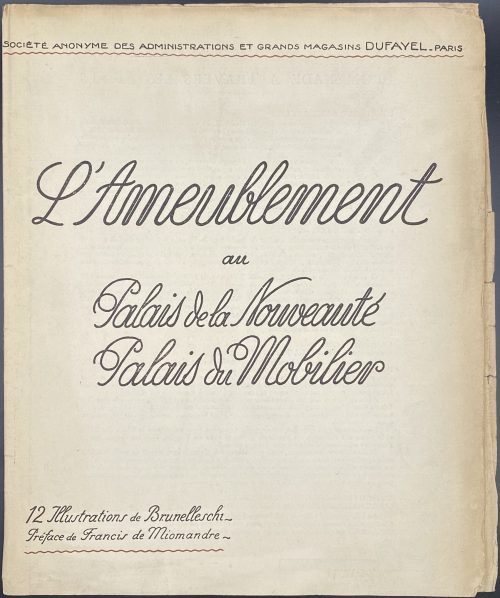 A set of 12 photomechanically reproduced illustrations after gouaches by Umberto Brunelleschi (Italian, 1879 – 1949), in colour; b/w photographs reproductions on verso, in a paper folder without the outer wrappers (b/w with birds, insects, and flowers). Text on the folder by French novelist Francis de Miomandre (French, 1880 – 1959); published by Grands Magasins Dufayel (1856 – 1930), a Parisian department store, run by Georges Dufayel (French, 1855 – 1916). Size: 29 x 24 cm. Images printed on cream paper within a beige frame, lettered above the frame in beige: "Societé Anonyme des Administrations et Grands Magasins DUFAYEL — Paris —", under the frame: "Palais de la Nouveauté ~ Palais du Mobilier | Entrée principale 7 Bould BARBES"; at the bottom of the frame lettered black on each image: Le Style Chinois, Le Style Empire, Le Style Japonais, Le Style Louis XIV, Le Style Louis XV, Le Style Louis XVI, Le Style Moderne (2), Le Style Moyen Age, Le Style Renaissance, Le Style Vénitien, Le Style Persian.
A set of 12 photomechanically reproduced illustrations after gouaches by Umberto Brunelleschi (Italian, 1879 – 1949), in colour; b/w photographs reproductions on verso, in a paper folder without the outer wrappers (b/w with birds, insects, and flowers). Text on the folder by French novelist Francis de Miomandre (French, 1880 – 1959); published by Grands Magasins Dufayel (1856 – 1930), a Parisian department store, run by Georges Dufayel (French, 1855 – 1916). Size: 29 x 24 cm. Images printed on cream paper within a beige frame, lettered above the frame in beige: "Societé Anonyme des Administrations et Grands Magasins DUFAYEL — Paris —", under the frame: "Palais de la Nouveauté ~ Palais du Mobilier | Entrée principale 7 Bould BARBES"; at the bottom of the frame lettered black on each image: Le Style Chinois, Le Style Empire, Le Style Japonais, Le Style Louis XIV, Le Style Louis XV, Le Style Louis XVI, Le Style Moderne (2), Le Style Moyen Age, Le Style Renaissance, Le Style Vénitien, Le Style Persian. -
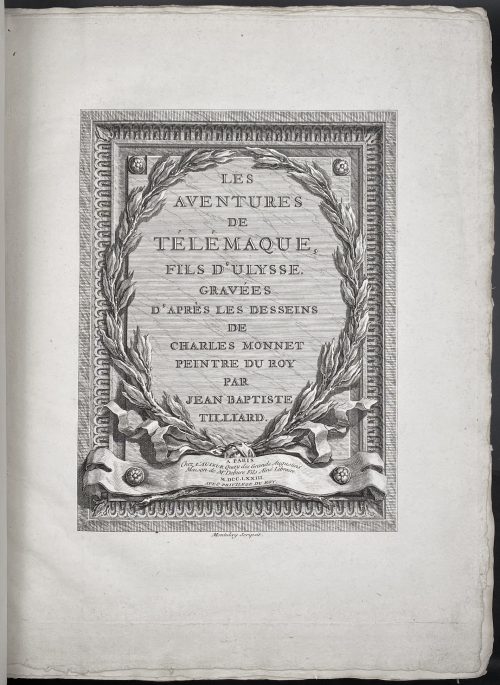 Vol. 1: Title page: LES AVENTURES | DE | TÉLÉMAQUE, | PAR FÉNELON. — | TOME PREMIER. | {publisher’s arms by Beugnet after Choffard} | DE L'IMPRIMERIE DE MONSIEUR. | M. DCC. LXXXV. || Title-frontispiece (engraved by Montulay): lettering within garland: Les Aventures de Télémaque, FILS D’ULYSSE. GRAVÉES | D’APRÈS LES DESSEINS | DE | CHARLES MONNET | PEINTRE DU ROY | PAR | JEAN BAPTISTE | TILLIARD. ||; Lettering on ribbon beneath the garland: A PARIS | Chez L’AUTEUR Quay des Grands Augustins | Maison de Mr. Debure Fils Aîné Libraire. M. DCC. LXXIII. | AVEC PRIVILEGE DU ROY. ||; Signed under the frame: Montulay Sculpsit. || Pagination: [2] – h.t. / imprint, [2] – t.p. / blank, [2] Advert., [2] d.t.p. / sommaire, [1] 2-309 [3 blanks], total 320 pages on thick wove paper plus engraved title-frontis. by Montulay, 12 engraved text leaves (one for each book), unsigned, and 36 plates (all in ornamental frame of laurel ribbon) by Tilliard after Monnet, all engravings on laid paper. Collation: 4to; vergé flyleaves at front and back, π4 A-2P4 plus 4 additional divisional titles in choirs C, F, I, and M for books 2-5, total 160 leaves, plus 49 plates. Vol. 2: Title page: Same but “TOME SECOND”. Pagination: [2] – h.t. / imprint, [2] – t.p. / blank, [1-3] 4-297 [298 blank] [2] – approb., total 304 pages plus 12 engraved text leaves (one for each book), and 36 plates, last 6 plates in a simple frame without the laurel ribbon and before signatures. Collation: 4to; π2 A-2O4 2P1 χ1, total 152 leaves, plus 48 plates. Binding: Two volumes uniformly bound in green paper boards with two red labels lettered in gilt, untrimmed. Size: overall 36.5 x 28 cm, platemark 32 x 25 cm, with white vergé flyleaves to front and back, similar pastedowns. Catalogue raisonné: Cohen, de Ricci (1912): 384-386; Ray (French): № 37, p. 74; Lewine (1898): p. 181. Contributors: François Fénelon [François de Salignac de la Mothe-Fénelon] (French, 1651 – 1715) – author. Choffard, Pierre Philippe (French, 1730 – 1809) – artist. Monnet, Charles (French, 1732 – after 1808) – artist. Montulay (French, fl. c. 1773) – engraver. Tilliard, Jean Baptiste (French, 1740 – 1813) – engraver. Beugnet, Jean (French, c. 1803) – engraver. Didot, Pierre-François (French, 1731 – 1795) – printer. Barrois, Louis-François (French, 1748 – 1835?); Barrois, Pierre-Théophile (French, 1752 – 1836); Onfroy, Eugène (French, before 1765 – 1809) ; Delalain, Louis-Alexandre (French, 1749? – 1798) – booksellers.
Vol. 1: Title page: LES AVENTURES | DE | TÉLÉMAQUE, | PAR FÉNELON. — | TOME PREMIER. | {publisher’s arms by Beugnet after Choffard} | DE L'IMPRIMERIE DE MONSIEUR. | M. DCC. LXXXV. || Title-frontispiece (engraved by Montulay): lettering within garland: Les Aventures de Télémaque, FILS D’ULYSSE. GRAVÉES | D’APRÈS LES DESSEINS | DE | CHARLES MONNET | PEINTRE DU ROY | PAR | JEAN BAPTISTE | TILLIARD. ||; Lettering on ribbon beneath the garland: A PARIS | Chez L’AUTEUR Quay des Grands Augustins | Maison de Mr. Debure Fils Aîné Libraire. M. DCC. LXXIII. | AVEC PRIVILEGE DU ROY. ||; Signed under the frame: Montulay Sculpsit. || Pagination: [2] – h.t. / imprint, [2] – t.p. / blank, [2] Advert., [2] d.t.p. / sommaire, [1] 2-309 [3 blanks], total 320 pages on thick wove paper plus engraved title-frontis. by Montulay, 12 engraved text leaves (one for each book), unsigned, and 36 plates (all in ornamental frame of laurel ribbon) by Tilliard after Monnet, all engravings on laid paper. Collation: 4to; vergé flyleaves at front and back, π4 A-2P4 plus 4 additional divisional titles in choirs C, F, I, and M for books 2-5, total 160 leaves, plus 49 plates. Vol. 2: Title page: Same but “TOME SECOND”. Pagination: [2] – h.t. / imprint, [2] – t.p. / blank, [1-3] 4-297 [298 blank] [2] – approb., total 304 pages plus 12 engraved text leaves (one for each book), and 36 plates, last 6 plates in a simple frame without the laurel ribbon and before signatures. Collation: 4to; π2 A-2O4 2P1 χ1, total 152 leaves, plus 48 plates. Binding: Two volumes uniformly bound in green paper boards with two red labels lettered in gilt, untrimmed. Size: overall 36.5 x 28 cm, platemark 32 x 25 cm, with white vergé flyleaves to front and back, similar pastedowns. Catalogue raisonné: Cohen, de Ricci (1912): 384-386; Ray (French): № 37, p. 74; Lewine (1898): p. 181. Contributors: François Fénelon [François de Salignac de la Mothe-Fénelon] (French, 1651 – 1715) – author. Choffard, Pierre Philippe (French, 1730 – 1809) – artist. Monnet, Charles (French, 1732 – after 1808) – artist. Montulay (French, fl. c. 1773) – engraver. Tilliard, Jean Baptiste (French, 1740 – 1813) – engraver. Beugnet, Jean (French, c. 1803) – engraver. Didot, Pierre-François (French, 1731 – 1795) – printer. Barrois, Louis-François (French, 1748 – 1835?); Barrois, Pierre-Théophile (French, 1752 – 1836); Onfroy, Eugène (French, before 1765 – 1809) ; Delalain, Louis-Alexandre (French, 1749? – 1798) – booksellers. -
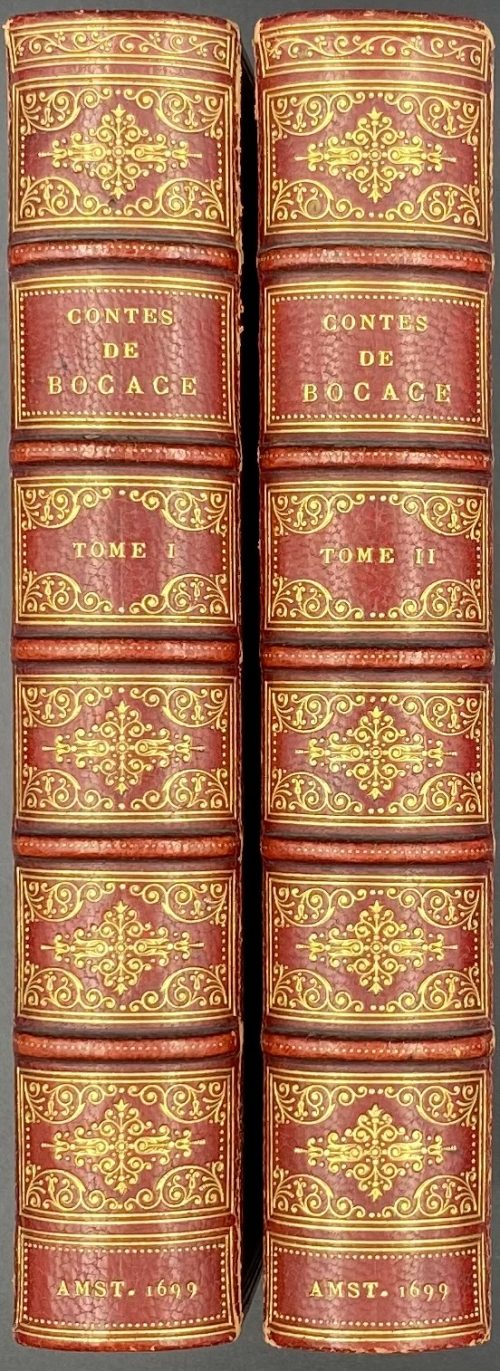 Vol. 1: Title page (in red and black): CONTES | ET | NOUVELLES | DE | BOCACE | FLORENTIN. | Traduction Libre, | Accommodée au gout de ce temps, & en- | richie de FIGURES en TAILLE- | DOUCE gravées par Mr. Romain | de Hooge. | TOME PREMIER. | {device} | A AMSTERDAM, | Chez GEORGE GALLET. | — | M. DC. XCIX. || Collation: 2 binder’s blank leaves, etched frontispiece or title, t.p. in red and black, *8 **4 (starting at *3, frontis. within collation of lacking one leaf) A—Y8 Z7, no final blank; 44 in-text half-page vignettes and one tipped-in additional plate (p. 212) in novella XXV (day 3, story 6: "Ricciardo Minutolo loves the wife of Filippello Fighinolfi, and knowing her to be jealous, makes her believe that his own wife is to meet Filippello at a Turkish bathhouse on an ensuing day; whereby she is induced to go thither, where, thinking to have been with her husband, she discovers that she has tarried with Ricciardo"), showing the ending of the story (45 illustrations total) Pagination: 12 unpaginated leaves [i-xxiv], pg. starts at A1, [1] 2-366. Vol. 2: Title-page: same as in vol. 1 but all in black and TOME SECOND. Collation: A-2D8 2E4, 56 in-text half-page vignettes. Pagination: [1,2] (t.p.), 3-427 (text) [13] (table, last page blank). Edition 1st edition, 2nd printing, edition of 1699 considered by most a re-issue of the 1697 edition. Description in Auction Sale Van Gendt, 1977, no. 1108: "The first, which has exactly the same collation was published by Gallet in 1697. It seems possible that the 1699 edition is, in fact, of the same issue, and that only the first quires of both volumes, which include the title pages were replaced by new ones with the new date, to make the book look more up to date. - The edition of 1702, also published by Gallet has "seconde édition", which, we think, sustains our theory." Binding: Two volumes uniformly bound by Chambolle-Duru in red crushed morocco, ruled gilt with triple-fillet, gilt dentelle inside, raised bands, gilt in compartments, AEG, marbled endpapers; to FEP verso in vol. 1 pasted a clipping, and in both volumes – bookplate “EX LIBRIS HELGE LOEWENBERG DOMP”. Provenance: Helge Loewenberg-Domp (Jewish-German, 1915 – 2021) Catalogue raisonnè: Landwehr (1970): № 88, p. 193 [LIB-2547.2020]. Contributors: Giovanni Boccaccio (Italian, 1313 – 1375) – author. Romeyn de Hooghe (Dutch, 1645 – 1708) – artist, etcher. Chambolle-Duru; René Victor Chambolle (French, 1834 – 1898), Hippolyte Duru (French, 1803 – 1884) – binder. George Gallet (Dutch, 17th-18th century) – printer, publisher.
Vol. 1: Title page (in red and black): CONTES | ET | NOUVELLES | DE | BOCACE | FLORENTIN. | Traduction Libre, | Accommodée au gout de ce temps, & en- | richie de FIGURES en TAILLE- | DOUCE gravées par Mr. Romain | de Hooge. | TOME PREMIER. | {device} | A AMSTERDAM, | Chez GEORGE GALLET. | — | M. DC. XCIX. || Collation: 2 binder’s blank leaves, etched frontispiece or title, t.p. in red and black, *8 **4 (starting at *3, frontis. within collation of lacking one leaf) A—Y8 Z7, no final blank; 44 in-text half-page vignettes and one tipped-in additional plate (p. 212) in novella XXV (day 3, story 6: "Ricciardo Minutolo loves the wife of Filippello Fighinolfi, and knowing her to be jealous, makes her believe that his own wife is to meet Filippello at a Turkish bathhouse on an ensuing day; whereby she is induced to go thither, where, thinking to have been with her husband, she discovers that she has tarried with Ricciardo"), showing the ending of the story (45 illustrations total) Pagination: 12 unpaginated leaves [i-xxiv], pg. starts at A1, [1] 2-366. Vol. 2: Title-page: same as in vol. 1 but all in black and TOME SECOND. Collation: A-2D8 2E4, 56 in-text half-page vignettes. Pagination: [1,2] (t.p.), 3-427 (text) [13] (table, last page blank). Edition 1st edition, 2nd printing, edition of 1699 considered by most a re-issue of the 1697 edition. Description in Auction Sale Van Gendt, 1977, no. 1108: "The first, which has exactly the same collation was published by Gallet in 1697. It seems possible that the 1699 edition is, in fact, of the same issue, and that only the first quires of both volumes, which include the title pages were replaced by new ones with the new date, to make the book look more up to date. - The edition of 1702, also published by Gallet has "seconde édition", which, we think, sustains our theory." Binding: Two volumes uniformly bound by Chambolle-Duru in red crushed morocco, ruled gilt with triple-fillet, gilt dentelle inside, raised bands, gilt in compartments, AEG, marbled endpapers; to FEP verso in vol. 1 pasted a clipping, and in both volumes – bookplate “EX LIBRIS HELGE LOEWENBERG DOMP”. Provenance: Helge Loewenberg-Domp (Jewish-German, 1915 – 2021) Catalogue raisonnè: Landwehr (1970): № 88, p. 193 [LIB-2547.2020]. Contributors: Giovanni Boccaccio (Italian, 1313 – 1375) – author. Romeyn de Hooghe (Dutch, 1645 – 1708) – artist, etcher. Chambolle-Duru; René Victor Chambolle (French, 1834 – 1898), Hippolyte Duru (French, 1803 – 1884) – binder. George Gallet (Dutch, 17th-18th century) – printer, publisher. -
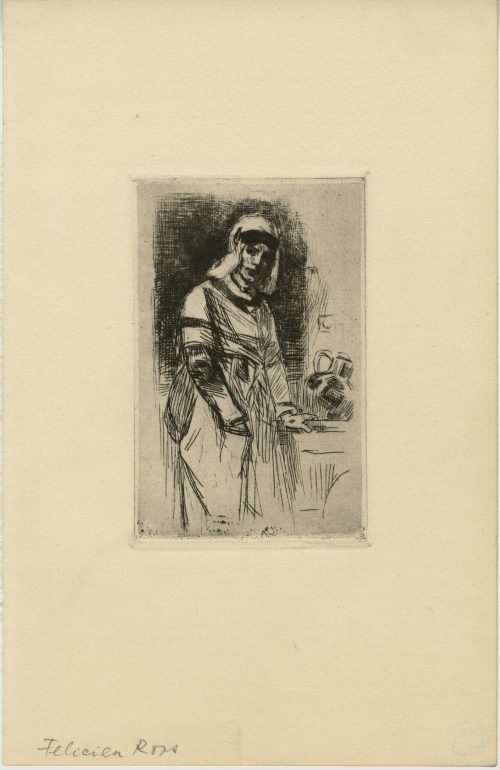
A woman from Antwerp or a servant, another title "Laitière anversoise"; 2nd state. Etching on wove paper. Owner's stamp LVM on verso.
Dimensions: Paper: 24.4 x 15.8 cm; Image: 12 x 7.5 cm
Catalogue raisonné: Arthur Hubschmid (1977): 343.
-
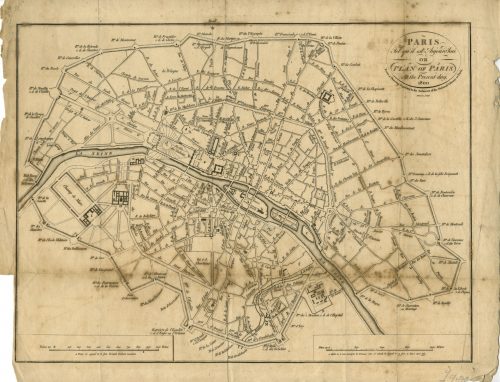 Title: PARIS | Tel qu'il est Aujourd'hui | OR | PLAN OF PARIS | At the Present day. 1800 | From a Drawing deposited in the Archieves of the National Library at Paris | Menzies sculpt. || Contributor: Menzies, John (British, fl. c. 1792 – 1851) – engraver. Ref: Gallica.
Title: PARIS | Tel qu'il est Aujourd'hui | OR | PLAN OF PARIS | At the Present day. 1800 | From a Drawing deposited in the Archieves of the National Library at Paris | Menzies sculpt. || Contributor: Menzies, John (British, fl. c. 1792 – 1851) – engraver. Ref: Gallica. -
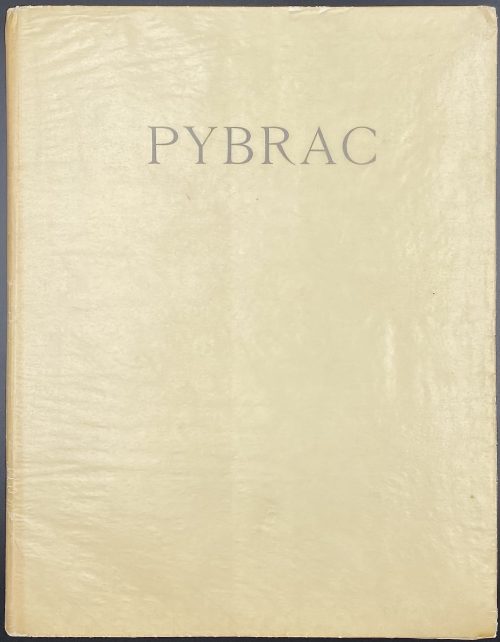 Description: One volume in French flapped cream wrappers, 25.5 x 19.5 cm, lettered “PYBRAC”, in glassine DJ, collated 4to, printed on watermarked Van Gelder laid paper, outer and bottom margins untrimmed, illustrated with 20 in-text drypoints on recto of each 1st and 3rd leaf of 1-10 gatherings, some with tipped-in tissue guards, unbound. This copy lacks the frontispiece, 10 full-page plates, and does not have any enrichment. It is one volume instead of two. Title-page: PYBRAC | ILLUSTRE DE TRENTE POINT SÈCHES | D’UN | ARTISTE INCONNU | PARIS | AUX DÉPENS D’UN AMATEUR | — | M. CM. XXVIII || Limitation: Edition limited to 30 copies, 1 copy unique on Japon Nacré with 30 original sketches, one suite in colour, two suites in black and 5 cancelled plates; 29 copies on Hollande Van Gelder, with one original watercolour, four original sketches, one suite in colour, two suites in black and 5 cancelled plates. This is copy № 8 (but without 11 full-page plates and with no enrichment). For a unique copy of the enriched edition in this collection, see LIB-3065.2022. Collation: π4 (2 blanks, h.t., t.p.), 1-104, χ2 (2 blanks), total 46 leaves. Pagination: [8] 1-78 [2] [4], total 92 pages. Catalogue raisonné: Dutel (1920-1970): № 2279, p. 334, Pia (Enfer):№ 1117, p. 586, Nordmann (I):№ 235; Vokaer № 23, p. 13; Fekete:№ 216. Contributors: Pierre Louÿs (French, 1870 – 1925) – author. Marcel Vertès [Marcell Vértes] (Jewish-Hungarian-French, 1895 – 1961) – artist.
Description: One volume in French flapped cream wrappers, 25.5 x 19.5 cm, lettered “PYBRAC”, in glassine DJ, collated 4to, printed on watermarked Van Gelder laid paper, outer and bottom margins untrimmed, illustrated with 20 in-text drypoints on recto of each 1st and 3rd leaf of 1-10 gatherings, some with tipped-in tissue guards, unbound. This copy lacks the frontispiece, 10 full-page plates, and does not have any enrichment. It is one volume instead of two. Title-page: PYBRAC | ILLUSTRE DE TRENTE POINT SÈCHES | D’UN | ARTISTE INCONNU | PARIS | AUX DÉPENS D’UN AMATEUR | — | M. CM. XXVIII || Limitation: Edition limited to 30 copies, 1 copy unique on Japon Nacré with 30 original sketches, one suite in colour, two suites in black and 5 cancelled plates; 29 copies on Hollande Van Gelder, with one original watercolour, four original sketches, one suite in colour, two suites in black and 5 cancelled plates. This is copy № 8 (but without 11 full-page plates and with no enrichment). For a unique copy of the enriched edition in this collection, see LIB-3065.2022. Collation: π4 (2 blanks, h.t., t.p.), 1-104, χ2 (2 blanks), total 46 leaves. Pagination: [8] 1-78 [2] [4], total 92 pages. Catalogue raisonné: Dutel (1920-1970): № 2279, p. 334, Pia (Enfer):№ 1117, p. 586, Nordmann (I):№ 235; Vokaer № 23, p. 13; Fekete:№ 216. Contributors: Pierre Louÿs (French, 1870 – 1925) – author. Marcel Vertès [Marcell Vértes] (Jewish-Hungarian-French, 1895 – 1961) – artist. -
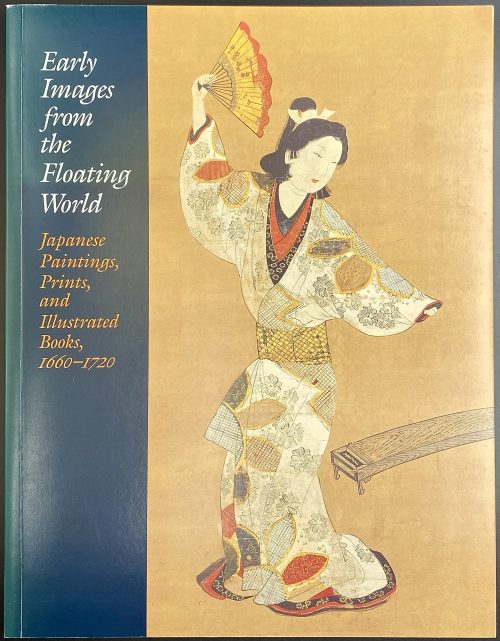 Softcover, in pictorial wrappers, 28 x 21.8 cm, 37 entries, with colour illustrations. Catalogue of the sales exhibition on March 3 - April 5, 2008 in NY; pagination: [1-3] 4-102 [2], ils. Contributor: Sebastian Izzard
Softcover, in pictorial wrappers, 28 x 21.8 cm, 37 entries, with colour illustrations. Catalogue of the sales exhibition on March 3 - April 5, 2008 in NY; pagination: [1-3] 4-102 [2], ils. Contributor: Sebastian Izzard -
 Poem by Ariwara no Narihira Ason: (Actor Ichikawa Danjûrô VIII as) Seigen, from the series Comparisons for Thirty-six Selected Poems (Mitate sanjûrokkasen no uchi)「見立三十六歌撰之内 有原業平朝臣 清玄」 八代目市川団十郎. Poem: Yo no naka ni/ taete sakura no/ nakariseba/ haru no kokoro wa/ nodokekaramashi. Kabuki actor: Ichikawa Danjūrō VIII [八代目 市川 團十郎] (Japanese, 1823 – 1854); other names: Ichikawa Ebizô VI, Ichikawa Shinnosuke II. Artist: Utagawa Kunisada [歌川 国貞] a.k.a. Utagawa Toyokuni III [三代歌川豊国] (Japanese, 1786 – 1865). Block cutter: Yokokawa Horitake [横川彫武] a.k.a. Yokokawa Takejiro [横川竹二郎] (Japanese, fl. 1860s). Publisher: Iseya Kanekichi [伊勢屋兼吉] (Japanese, fl. 1840s – c. 1875) Year: 1852 (Kaei 5), 10th month. Size: Vertical ōban; 36.5 × 25.4 cm. Signed: Toyokuni ga, in toshidama cartouche [豊国画(年玉枠] Censors' seals: Fuku, (Muramatsu), Rat 10. Ref: MFA Accession № 11.36779.43.
Poem by Ariwara no Narihira Ason: (Actor Ichikawa Danjûrô VIII as) Seigen, from the series Comparisons for Thirty-six Selected Poems (Mitate sanjûrokkasen no uchi)「見立三十六歌撰之内 有原業平朝臣 清玄」 八代目市川団十郎. Poem: Yo no naka ni/ taete sakura no/ nakariseba/ haru no kokoro wa/ nodokekaramashi. Kabuki actor: Ichikawa Danjūrō VIII [八代目 市川 團十郎] (Japanese, 1823 – 1854); other names: Ichikawa Ebizô VI, Ichikawa Shinnosuke II. Artist: Utagawa Kunisada [歌川 国貞] a.k.a. Utagawa Toyokuni III [三代歌川豊国] (Japanese, 1786 – 1865). Block cutter: Yokokawa Horitake [横川彫武] a.k.a. Yokokawa Takejiro [横川竹二郎] (Japanese, fl. 1860s). Publisher: Iseya Kanekichi [伊勢屋兼吉] (Japanese, fl. 1840s – c. 1875) Year: 1852 (Kaei 5), 10th month. Size: Vertical ōban; 36.5 × 25.4 cm. Signed: Toyokuni ga, in toshidama cartouche [豊国画(年玉枠] Censors' seals: Fuku, (Muramatsu), Rat 10. Ref: MFA Accession № 11.36779.43. -
 Artist: Utagawa Kunisada [歌川 国貞] a.k.a. Utagawa Toyokuni III [三代歌川豊国] (Japanese, 1786 – 1865). Signed: Ōju Toyokuni ga [応需豊国画] in a toshidama cartouche. Double nanushi censor seals Mera & Murata (1846-50). Publisher: Kojimaya Jūbei [小嶋屋重兵衛] (Japanese, fl. c. 1797 – 1869). A gentleman, probably a kabuki actor Nakamura Utaemon IV [中村歌右衛門] (Nakamura Shikan II, Nakamura Tsurusuke I, Nakamura Tōtarō, Japanese, 1796 – 1852) drinking tea on a veranda under the shining moon. Series Moon, Sun, Stars [月日星] (tsuki-hi-hoshi/boshi), the three sources of light (sankō) [三光]:
Artist: Utagawa Kunisada [歌川 国貞] a.k.a. Utagawa Toyokuni III [三代歌川豊国] (Japanese, 1786 – 1865). Signed: Ōju Toyokuni ga [応需豊国画] in a toshidama cartouche. Double nanushi censor seals Mera & Murata (1846-50). Publisher: Kojimaya Jūbei [小嶋屋重兵衛] (Japanese, fl. c. 1797 – 1869). A gentleman, probably a kabuki actor Nakamura Utaemon IV [中村歌右衛門] (Nakamura Shikan II, Nakamura Tsurusuke I, Nakamura Tōtarō, Japanese, 1796 – 1852) drinking tea on a veranda under the shining moon. Series Moon, Sun, Stars [月日星] (tsuki-hi-hoshi/boshi), the three sources of light (sankō) [三光]: -
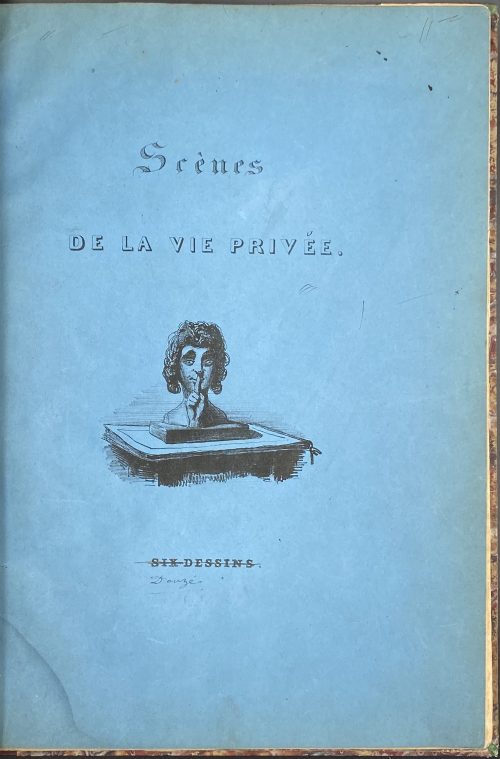 Pictorial album 31 x 22.8 cm, bound in quarter red calf over marbled boards with gilt lettering “SCÈNES | DE | LA VIE | PRIVÉE” and gilt ornament to spine; marbled endpapers, flyleaf, blue original wrapper (title-page) lettered SCÈNES | DE LA VIE PRIVÉE. | {vignette} | SIX DESSINS || «Six dessins» struck out, ms inscription beneath “Douze”. Twelve hand-coloured lithographs, some inscribed with letters and/or numbers in reverse, each in a double-rule frame 22 x 16.5 cm, images 18 x 14.5 cm (approx.); series title “Scènes de la vie intime” printed above the frame, image title printed in the lower compartment; ms numbers above the upper-right corner of the frame (state before sequential numbers, ms numbers do not correspond with artist numbering). Flyleaf at the end. Two bookplates to front pastedown: “EX-LIBRIS PAUL GAVAULT” and armorial “IN ROBORE ROBUR | Ex Libris Bourlon de Rouvre”. Content (Roman numerals in parenthesis are publisher's numbers; numerals in italic are Armelhault-Bocher reference numbers):
Pictorial album 31 x 22.8 cm, bound in quarter red calf over marbled boards with gilt lettering “SCÈNES | DE | LA VIE | PRIVÉE” and gilt ornament to spine; marbled endpapers, flyleaf, blue original wrapper (title-page) lettered SCÈNES | DE LA VIE PRIVÉE. | {vignette} | SIX DESSINS || «Six dessins» struck out, ms inscription beneath “Douze”. Twelve hand-coloured lithographs, some inscribed with letters and/or numbers in reverse, each in a double-rule frame 22 x 16.5 cm, images 18 x 14.5 cm (approx.); series title “Scènes de la vie intime” printed above the frame, image title printed in the lower compartment; ms numbers above the upper-right corner of the frame (state before sequential numbers, ms numbers do not correspond with artist numbering). Flyleaf at the end. Two bookplates to front pastedown: “EX-LIBRIS PAUL GAVAULT” and armorial “IN ROBORE ROBUR | Ex Libris Bourlon de Rouvre”. Content (Roman numerals in parenthesis are publisher's numbers; numerals in italic are Armelhault-Bocher reference numbers):- Titre de la couverture (Title-page) – 2001
- (III) Un nid dans les blés (A nest in the wheat) – 2004
- (II) Amitié de pension (Friendship in the pension) – 2003
- (XI) Bras dessus, bras dessous (Arm up, arm down) – 2012
- (I) Causerie (Chat) – 2002
- (VI) Prélude (Prelude) – 2007
- (IX) Le guet-apens (Ambush) – 2010
- (V) Le cabinet noir (The dark chamber) – 2006
- (IV) Distraction (Entertainment) – 2005
- (X) Leçon de paysage (Landscape lesson) – 2011
- (VII) Avant le péché (Before sin) – 2008
- (VIII) Après le péché (After sin) – 2009
- (XII) La femme du peintre (The painter's wife) – 2013
-
 Artist: Utagawa Kunisada [歌川 国貞] a.k.a. Utagawa Toyokuni III [三代歌川豊国] (Japanese, 1786 – 1865). Signed: Ichiyōsai Toyokuni hitsu [一陽斎豊国筆]. Inscriptions: [松竹梅] Shochikubai = pine (matsu, 松), bamboo (take, 竹), and plum (ume, 梅) – an auspicious grouping known as “The Three Friends of Winter“; [三福追] (Sanpuku tsui) – the three delights, or pleasures. Date seal and aratame censor seal: Ansei 2, 1st month (1855). Publisher: Ibaya Senzaburō [伊場屋仙三郎] (Japanese, c. 1815 – 1869). Block carver: Yokokawa Takejirō [横川竹二郎] (Japanese, fl. 1845 – 1863); seal: Hori Take [彫竹]. Kabuki actor Onoe Kikugorō V [五代目尾上菊五郎] (Onoe Baikō V, Ichimura Kakitsu IV, Ichimura Uzaemon XIII, Ichimura Kurōemon, Japanese, 1844 – 1903) giving candies to the memorial portrait of his predecessor, Ichimura Takenojō V [市村竹之丞] (Ichimura Uzaemon XII, Ichimura Kamenosuke, Ichimura Toyomatsu, Japanese, 1812 – 1851); the latter is dressed in a green robe adorned with a crest (mon) of a kōrin-style crane in a tortoiseshell (octagon), the hanging scroll border decorated with bamboo under snow; the collar of Onoe's kimono decorated with plum blossoms, another plum blossom arrangement decorates the screen behind him. Actors identified by Horst Graebner. Two fan prints from this series in Varshavsky Collection:
Artist: Utagawa Kunisada [歌川 国貞] a.k.a. Utagawa Toyokuni III [三代歌川豊国] (Japanese, 1786 – 1865). Signed: Ichiyōsai Toyokuni hitsu [一陽斎豊国筆]. Inscriptions: [松竹梅] Shochikubai = pine (matsu, 松), bamboo (take, 竹), and plum (ume, 梅) – an auspicious grouping known as “The Three Friends of Winter“; [三福追] (Sanpuku tsui) – the three delights, or pleasures. Date seal and aratame censor seal: Ansei 2, 1st month (1855). Publisher: Ibaya Senzaburō [伊場屋仙三郎] (Japanese, c. 1815 – 1869). Block carver: Yokokawa Takejirō [横川竹二郎] (Japanese, fl. 1845 – 1863); seal: Hori Take [彫竹]. Kabuki actor Onoe Kikugorō V [五代目尾上菊五郎] (Onoe Baikō V, Ichimura Kakitsu IV, Ichimura Uzaemon XIII, Ichimura Kurōemon, Japanese, 1844 – 1903) giving candies to the memorial portrait of his predecessor, Ichimura Takenojō V [市村竹之丞] (Ichimura Uzaemon XII, Ichimura Kamenosuke, Ichimura Toyomatsu, Japanese, 1812 – 1851); the latter is dressed in a green robe adorned with a crest (mon) of a kōrin-style crane in a tortoiseshell (octagon), the hanging scroll border decorated with bamboo under snow; the collar of Onoe's kimono decorated with plum blossoms, another plum blossom arrangement decorates the screen behind him. Actors identified by Horst Graebner. Two fan prints from this series in Varshavsky Collection:
SVJP-0335.2021
-
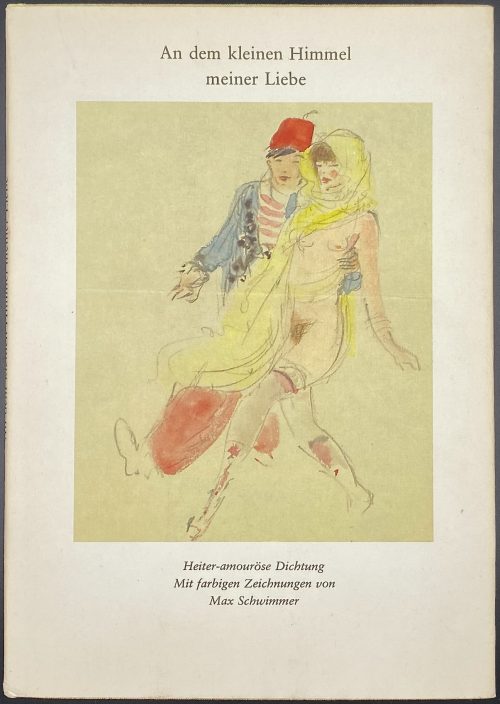 Description: bound in light yellow cloth with red and orange geometrical design to front cover and black lettering to spine, in pictorial DJ “An dem kleinen Himmel | meiner Liebe | {colour vignette} | Heiter-amouröse Dichtung | Mit 24 farbigen Zeichnungen von | Max Schwimmer”; pp.: [1-6] 7-95 [96], total 48 leaves, with 22 offset colour full-page illustrations, DJ and title-page vignettes by Max Schwimmer; plates with pagination. Anthology of German love poetry from Caspar Stieler (1632 – 1707) to Wolfgang Tilgner (1932 – 2011). Title-page: An dem kleinen Himmel | meiner Liebe | Heiter-amouröse Dichtung | Mit 24 farbigen Zeichnungen | von Max Schwimmer | {vignette} | Verlag der Nation | Berlin || Contributors: Bruno Brandl (German, fl. c. 1969 – 1991)– editor. Max Schwimmer (German, 1895 – 1960) – artist. VEB Druckhaus “Maxim Gorki” (Altenburg) – printer. Verlag der Nation (Berlin) – publisher.
Description: bound in light yellow cloth with red and orange geometrical design to front cover and black lettering to spine, in pictorial DJ “An dem kleinen Himmel | meiner Liebe | {colour vignette} | Heiter-amouröse Dichtung | Mit 24 farbigen Zeichnungen von | Max Schwimmer”; pp.: [1-6] 7-95 [96], total 48 leaves, with 22 offset colour full-page illustrations, DJ and title-page vignettes by Max Schwimmer; plates with pagination. Anthology of German love poetry from Caspar Stieler (1632 – 1707) to Wolfgang Tilgner (1932 – 2011). Title-page: An dem kleinen Himmel | meiner Liebe | Heiter-amouröse Dichtung | Mit 24 farbigen Zeichnungen | von Max Schwimmer | {vignette} | Verlag der Nation | Berlin || Contributors: Bruno Brandl (German, fl. c. 1969 – 1991)– editor. Max Schwimmer (German, 1895 – 1960) – artist. VEB Druckhaus “Maxim Gorki” (Altenburg) – printer. Verlag der Nation (Berlin) – publisher. -
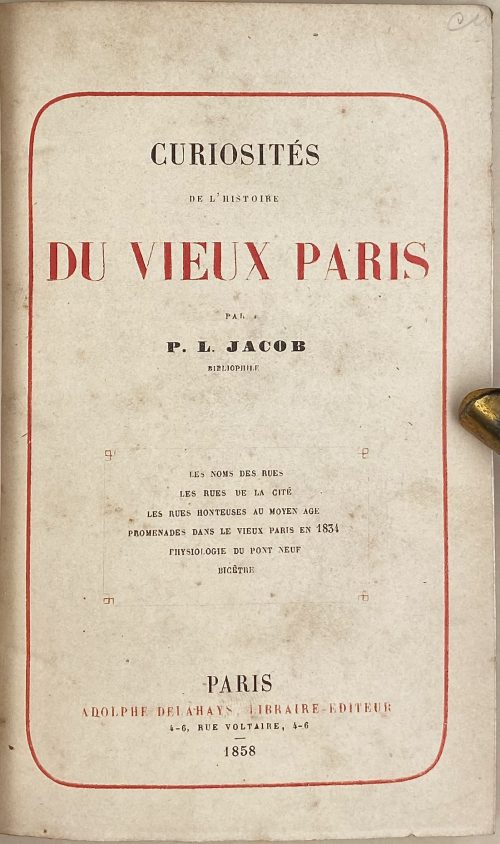 Title-page: CURIOSITÉS | DE L’HISTOIRE | DU VIEUX PARIS | PAR | P. L. JACOB | BIBLIOPHILE | { LES NOMS DES RUES | LES RUES DE CITÉ | LES RUES HONTEUSES AU MOYEN AGE. | PROMENADES DANS LE VIEUX PARIS EN 1834. | PHYSIOLOGIE DU PONT NEUF. | BICÊTRE } | PARIS | ADOLPHE DELAHAYS, LIBRAIRE-ÉDITEUR | 4-6, RUE VOLTAIRE, 4-6 | – | 1858 || Description: Hardcover, in-16o, 17 x 11 cm, quarter brown morocco over marbled boards, spine with raised bands, gilt lettering, gilt fleurons, marbled endpapers, original wrappers with red and black lettering within red frame bound in, some pages uncut. Collation: 8vo; π2 14, 2-238 244, total 186 leaves between original wrappers. Pagination: [4] [1] 2-364 [4], total 372 pages. Catalogue raisonné: Vicar: I, 770. Contributors: Printer: Simon Raçon et Comp. (Paris). Author: Paul Lacroix [P. L. Jacob] (French, 1806 – 1884). Publisher: Adolphe Delahays (French, mid-19th century).
Title-page: CURIOSITÉS | DE L’HISTOIRE | DU VIEUX PARIS | PAR | P. L. JACOB | BIBLIOPHILE | { LES NOMS DES RUES | LES RUES DE CITÉ | LES RUES HONTEUSES AU MOYEN AGE. | PROMENADES DANS LE VIEUX PARIS EN 1834. | PHYSIOLOGIE DU PONT NEUF. | BICÊTRE } | PARIS | ADOLPHE DELAHAYS, LIBRAIRE-ÉDITEUR | 4-6, RUE VOLTAIRE, 4-6 | – | 1858 || Description: Hardcover, in-16o, 17 x 11 cm, quarter brown morocco over marbled boards, spine with raised bands, gilt lettering, gilt fleurons, marbled endpapers, original wrappers with red and black lettering within red frame bound in, some pages uncut. Collation: 8vo; π2 14, 2-238 244, total 186 leaves between original wrappers. Pagination: [4] [1] 2-364 [4], total 372 pages. Catalogue raisonné: Vicar: I, 770. Contributors: Printer: Simon Raçon et Comp. (Paris). Author: Paul Lacroix [P. L. Jacob] (French, 1806 – 1884). Publisher: Adolphe Delahays (French, mid-19th century). -
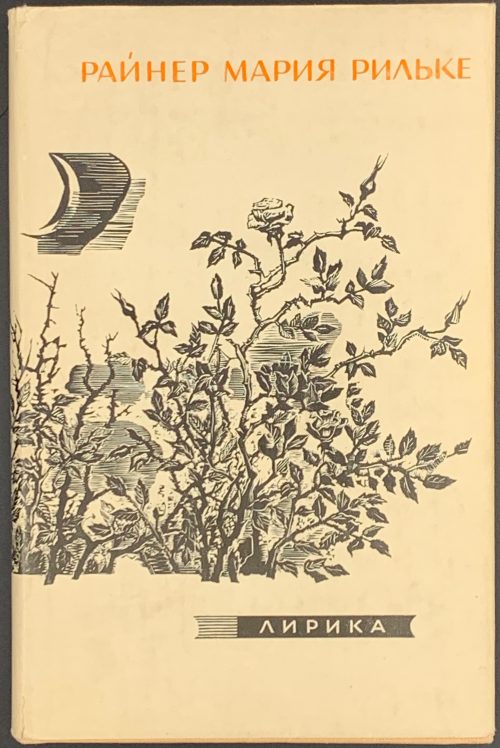 Small volume 17 x 11.5 cm, bound in tan cloth with brown lettering to front cover and spine, gilt fillets to spine, in wood-engraved pictorial dust jacket; pp.: [1-4] 5-254 [2], total 256 pages; collated in-16mo: [1]-816, total 128 leaves; wood-engraved portrait frontispiece within collation. Print run: 35,000 copies. Title-page (red and black): Райнер Мария Рильке | ЛИРИКА | Перевод с немецкого | Т. Сильман | {publisher’s device} | Издательство «Художественная литература» | Москва • 1956 • Ленинград || Contributors: Rainer Maria Rilke (German, 1875 – 1926) Тамара Исааковна Сильман (Russian-Jewish, 1909 – 1974) Владимир Григорьевич Адмони (Russian-Jewish, 1909 – 1993)
Small volume 17 x 11.5 cm, bound in tan cloth with brown lettering to front cover and spine, gilt fillets to spine, in wood-engraved pictorial dust jacket; pp.: [1-4] 5-254 [2], total 256 pages; collated in-16mo: [1]-816, total 128 leaves; wood-engraved portrait frontispiece within collation. Print run: 35,000 copies. Title-page (red and black): Райнер Мария Рильке | ЛИРИКА | Перевод с немецкого | Т. Сильман | {publisher’s device} | Издательство «Художественная литература» | Москва • 1956 • Ленинград || Contributors: Rainer Maria Rilke (German, 1875 – 1926) Тамара Исааковна Сильман (Russian-Jewish, 1909 – 1974) Владимир Григорьевич Адмони (Russian-Jewish, 1909 – 1993) -
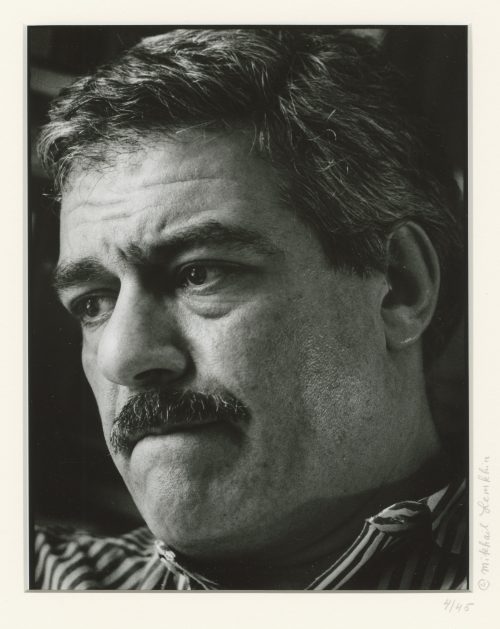 Photographic portrait of writer Andrei Sinyavsky, head and shoulder, turned to the left, wearing glasses. Pencil-signed on the mat: 4/45 • ©Mikhail Lemkhin; on the back of the print: Copyright statement stamp; ink stamp ©MIKHAIL LEMKHIN; ink stamp: PHOTO BY MIKHAIL LEMKHIN | 1811 38TH AVENUE | SAN FRANCISCO, CA 94122 | (415) 664-7677; pencil inscription on the back of the mat: (top) АНДРЕЙ СИНЯВСКИЙ | ANDREI SINYAVSKY, (bottom) XXIX. Size: mat: 43.2 x 35.5 cm; window: 23.5 x 18.5 cm; print: 25.2 x 20.2 cm. Limited edition of 45, of which this is № 4, signed and stamped by the artist. Sitter: Sergei Dovlatov [Сергей Донатович Довлатов] (Russian, 1941 – 1990)
Photographic portrait of writer Andrei Sinyavsky, head and shoulder, turned to the left, wearing glasses. Pencil-signed on the mat: 4/45 • ©Mikhail Lemkhin; on the back of the print: Copyright statement stamp; ink stamp ©MIKHAIL LEMKHIN; ink stamp: PHOTO BY MIKHAIL LEMKHIN | 1811 38TH AVENUE | SAN FRANCISCO, CA 94122 | (415) 664-7677; pencil inscription on the back of the mat: (top) АНДРЕЙ СИНЯВСКИЙ | ANDREI SINYAVSKY, (bottom) XXIX. Size: mat: 43.2 x 35.5 cm; window: 23.5 x 18.5 cm; print: 25.2 x 20.2 cm. Limited edition of 45, of which this is № 4, signed and stamped by the artist. Sitter: Sergei Dovlatov [Сергей Донатович Довлатов] (Russian, 1941 – 1990) -
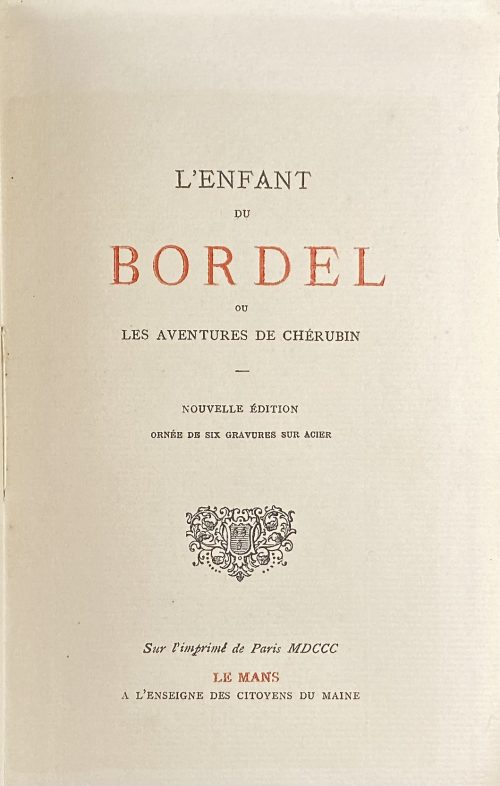 Softcover volume, 17.5 x 11 cm, in-12, brown wrappers without lettering, text printed on laid paper, six plates on India paper barbarously glued in, pp.: fep, [4] (h.t. t.p.), [1-3] 4-182, fep. Title-page (red and black): L’ENFANT | DU | BORDEL | OU | LES AVENTURES DE CHÉRUBIN | – | NOUVELLE ÉDITION | ORNÉE DE SIX GRAVURES SUR ACIER | {fleuron} | Sur l’imprimé de Paris MDCCC | LE MANS | A L’ENSEIGNE DES CITOYENS DU MAINE || Catalogue raisonné: Dutel I: A-325; Pia 395: 222 pages (we have 182 as per Dutel), attributes publication to Poulet-Malassis, 1866. Catalogue Poulet-Malassis & ses amis description: № 82.[PIGAULT-LEBRUN]. L’Enfant du Bordel, ou Les Aventures de Chérubin, nouvelle édition, ornée de six gravures sur acier. Sur l’imprimé de Paris, MDCCC, Le Mans, à l’enseigne des citoyens du Maine. [A. Christiaens, 1875 ?]. In-12, broché. 2 .n.ch., 182 pages, 1 f. blanc, couverture muette en papier vieux orange. Illustré de 6 figures hors-texte sur acier. Bibliographie : G* 553 (40 frs), Dutel A-325. Contributors: Guillaume Charles Antoine Pigault de l'Espinoy [Pigault-Lebrun] (French, 1753 – 1835) – author. Alexis Christiaens (Belgian, d. 1880) – publisher.
Softcover volume, 17.5 x 11 cm, in-12, brown wrappers without lettering, text printed on laid paper, six plates on India paper barbarously glued in, pp.: fep, [4] (h.t. t.p.), [1-3] 4-182, fep. Title-page (red and black): L’ENFANT | DU | BORDEL | OU | LES AVENTURES DE CHÉRUBIN | – | NOUVELLE ÉDITION | ORNÉE DE SIX GRAVURES SUR ACIER | {fleuron} | Sur l’imprimé de Paris MDCCC | LE MANS | A L’ENSEIGNE DES CITOYENS DU MAINE || Catalogue raisonné: Dutel I: A-325; Pia 395: 222 pages (we have 182 as per Dutel), attributes publication to Poulet-Malassis, 1866. Catalogue Poulet-Malassis & ses amis description: № 82.[PIGAULT-LEBRUN]. L’Enfant du Bordel, ou Les Aventures de Chérubin, nouvelle édition, ornée de six gravures sur acier. Sur l’imprimé de Paris, MDCCC, Le Mans, à l’enseigne des citoyens du Maine. [A. Christiaens, 1875 ?]. In-12, broché. 2 .n.ch., 182 pages, 1 f. blanc, couverture muette en papier vieux orange. Illustré de 6 figures hors-texte sur acier. Bibliographie : G* 553 (40 frs), Dutel A-325. Contributors: Guillaume Charles Antoine Pigault de l'Espinoy [Pigault-Lebrun] (French, 1753 – 1835) – author. Alexis Christiaens (Belgian, d. 1880) – publisher. -
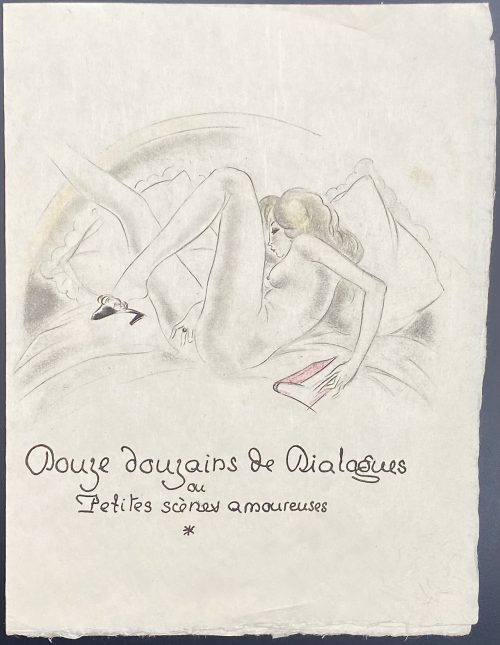 Description: An unbound softcover volume 23 x 18 cm, collated as 17 gatherings in 4to, text in fac-simile manuscript printed on Japon Nacre wove paper with untrimmed outer and bottom margins, with engraved title-page and 11 laid-in hand-coloured etchings after André Collot; in red quarter morocco over marbled boards folder with gilt lettering to spine “P. L. | ~ | PETITES | SCÈNES | AMOUREUSES”, in a matching slipcase 25 x 20 cm. Complete copy with all the pages, incl. the limitation page. Title-page: {vignette in colour} | Douze douzains de Dialogues | ou | Petites scènes amoureuses | * || (text in fac-simile ms). Limitation: Cet ouvrage a été tiré | sure Japn supernacré | à 100 exemplaire | numerotés de I à C | EXEMPLAIRE № LII. Content: (97 dialogues, not 144), similar to Pia: Premier douzain : Dialogues des Filles nues (1, 3, 4, 5, 6) – 5 dialogues; Deuxième douzain : Dialogue[s] des Masturbées (13, 14, 15, 16, 17, 18, 19, 20, [21]) – 9 dialogues; Troisième douzain : Dialogues des Masturbées (25, 26, 27, [28], 29, 30, 31, 32, 33) – 9 dialogues; Quatrième douzain : Dialogues des Lécheuses (37, 38, 39, 40, 41, 42, 44) – 7 dialogues; Cinquième douzain : Dialogues des Phallophores (49, 50, 51, 52, 53, 54) – 6 dialogues; Sixième douzain : Dialogues des Goules (61, 62, 63, 64, 65, 65 (i.e. 66), 67, 68, 69, 70, 71) – 11 dialogues; Septième douzain : Dialogues des Amoureuses (73, 74, 75, 76, 77, 78, 79, [80]) – 8 dialogues; Huitième douzain : Dialogues des Enculées (85, 86, 87, 88, 89, 90, 91, 92, 93, 94, [95]) – 11 dialogues; Neuvième douzain : Dialogues des Chieuses (97, 98, 99, 100, 101, 102, 104) – 7 dialogues; Dixième douzain : Dialogues des Pisseuses (109, 110, 111, 112, 114) – 5 dialogues; Onzième douzain : Dialogues des Mères (121, 122, 123, 124, 125, 126, 127, 128, 129, 130, 131, 132) – 12 dialogues; Douzième douzain : Dialogues des Enfants (134, 135, 136, 137, 138, 139, [140]) – 7 dialogues. Collation: [1]-[17]4; total 68 leaves plus 11 plates. See another copy of the same book in this collection [LIB-2819.2021], where 13 (blank/limitation) is missing. Edition: This copy of "calligraphié" Douze douzains de dialogues ou petites scènes amoureuses was most probably published in Paris by Libraire Robert Télin in 1927, 100 copies on Japon Nacre as per Dutel (1920-1970) № 1427. This is a complete copy with all 68 leaves; LIB-2819.2021 has 67 leaves. Another "calligraphié" edition published in c. 1940 (Dutel 1429) is bound and has 80 leaves. Dutel unequivocally attributes the drawings to André Collot. Plates in this copy are similar to the ones in a pirated copy of Scènes de péripatéticiennes / Douze douzains de dialogues [LIB-2961.2022] (Dutel № 2366). According to Pia (1978) № 358, this is a 1927 edition published in Paris by libraire Robert Télin: « 1 f. blanc, 1 f. (justification), 1 f. (titre) et 65 ff. n. ch., plus 11 gravures à l’eau-forte rehaussées de couleurs ». Edition limited to 100 copies numbered I – C; this copy is № LII (52). Catalogue raisonné: Dutel (1920-1970) №№ 1427 and 1429, p. 137 and № 2366, p. 356 ; Pia (1978) 358-9, p. 199-200. Contributors: Pierre Louÿs (French, 1870 – 1925) – author. André Collot (French, 1897 – 1976) – artist.
Description: An unbound softcover volume 23 x 18 cm, collated as 17 gatherings in 4to, text in fac-simile manuscript printed on Japon Nacre wove paper with untrimmed outer and bottom margins, with engraved title-page and 11 laid-in hand-coloured etchings after André Collot; in red quarter morocco over marbled boards folder with gilt lettering to spine “P. L. | ~ | PETITES | SCÈNES | AMOUREUSES”, in a matching slipcase 25 x 20 cm. Complete copy with all the pages, incl. the limitation page. Title-page: {vignette in colour} | Douze douzains de Dialogues | ou | Petites scènes amoureuses | * || (text in fac-simile ms). Limitation: Cet ouvrage a été tiré | sure Japn supernacré | à 100 exemplaire | numerotés de I à C | EXEMPLAIRE № LII. Content: (97 dialogues, not 144), similar to Pia: Premier douzain : Dialogues des Filles nues (1, 3, 4, 5, 6) – 5 dialogues; Deuxième douzain : Dialogue[s] des Masturbées (13, 14, 15, 16, 17, 18, 19, 20, [21]) – 9 dialogues; Troisième douzain : Dialogues des Masturbées (25, 26, 27, [28], 29, 30, 31, 32, 33) – 9 dialogues; Quatrième douzain : Dialogues des Lécheuses (37, 38, 39, 40, 41, 42, 44) – 7 dialogues; Cinquième douzain : Dialogues des Phallophores (49, 50, 51, 52, 53, 54) – 6 dialogues; Sixième douzain : Dialogues des Goules (61, 62, 63, 64, 65, 65 (i.e. 66), 67, 68, 69, 70, 71) – 11 dialogues; Septième douzain : Dialogues des Amoureuses (73, 74, 75, 76, 77, 78, 79, [80]) – 8 dialogues; Huitième douzain : Dialogues des Enculées (85, 86, 87, 88, 89, 90, 91, 92, 93, 94, [95]) – 11 dialogues; Neuvième douzain : Dialogues des Chieuses (97, 98, 99, 100, 101, 102, 104) – 7 dialogues; Dixième douzain : Dialogues des Pisseuses (109, 110, 111, 112, 114) – 5 dialogues; Onzième douzain : Dialogues des Mères (121, 122, 123, 124, 125, 126, 127, 128, 129, 130, 131, 132) – 12 dialogues; Douzième douzain : Dialogues des Enfants (134, 135, 136, 137, 138, 139, [140]) – 7 dialogues. Collation: [1]-[17]4; total 68 leaves plus 11 plates. See another copy of the same book in this collection [LIB-2819.2021], where 13 (blank/limitation) is missing. Edition: This copy of "calligraphié" Douze douzains de dialogues ou petites scènes amoureuses was most probably published in Paris by Libraire Robert Télin in 1927, 100 copies on Japon Nacre as per Dutel (1920-1970) № 1427. This is a complete copy with all 68 leaves; LIB-2819.2021 has 67 leaves. Another "calligraphié" edition published in c. 1940 (Dutel 1429) is bound and has 80 leaves. Dutel unequivocally attributes the drawings to André Collot. Plates in this copy are similar to the ones in a pirated copy of Scènes de péripatéticiennes / Douze douzains de dialogues [LIB-2961.2022] (Dutel № 2366). According to Pia (1978) № 358, this is a 1927 edition published in Paris by libraire Robert Télin: « 1 f. blanc, 1 f. (justification), 1 f. (titre) et 65 ff. n. ch., plus 11 gravures à l’eau-forte rehaussées de couleurs ». Edition limited to 100 copies numbered I – C; this copy is № LII (52). Catalogue raisonné: Dutel (1920-1970) №№ 1427 and 1429, p. 137 and № 2366, p. 356 ; Pia (1978) 358-9, p. 199-200. Contributors: Pierre Louÿs (French, 1870 – 1925) – author. André Collot (French, 1897 – 1976) – artist. -
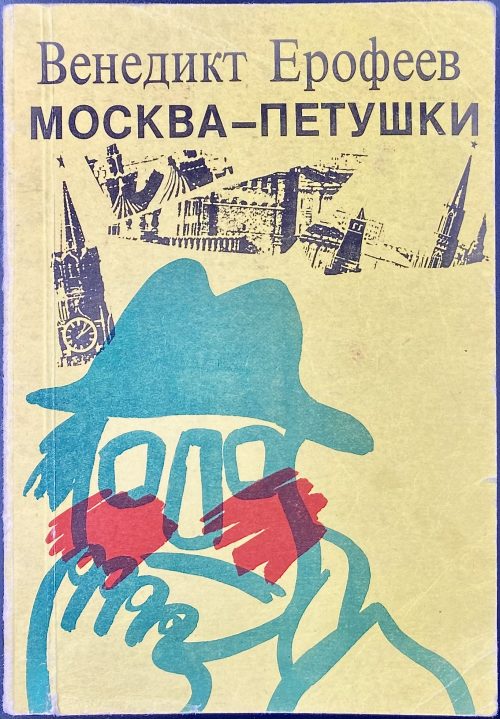 Paperback, 17.2 x 12 cm, yellow pictorial wrappers, lettering to front, back, and spine; pp.: [1-4] 5-137 [5]. Title-page: ВЕНЕДИКТ | ЕРОФЕЕВ | МОСКВА — ПЕТУШКИ | ПОВЕСТЬ | Таллинн | “Александра” | 1990 || Print-run: 30,000. Contributors: Венедикт Васильевич Ерофеев [Venedikt Yerofeyev] (Russian, 1938 – 1990) – author.
Paperback, 17.2 x 12 cm, yellow pictorial wrappers, lettering to front, back, and spine; pp.: [1-4] 5-137 [5]. Title-page: ВЕНЕДИКТ | ЕРОФЕЕВ | МОСКВА — ПЕТУШКИ | ПОВЕСТЬ | Таллинн | “Александра” | 1990 || Print-run: 30,000. Contributors: Венедикт Васильевич Ерофеев [Venedikt Yerofeyev] (Russian, 1938 – 1990) – author. -
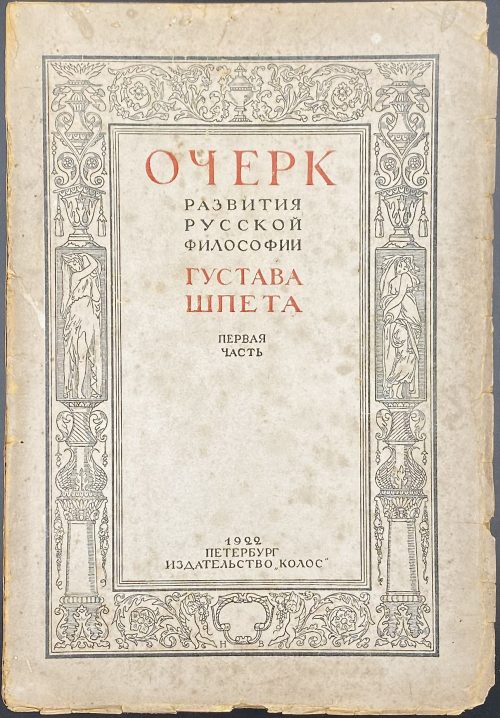 Paperback, 25 x 17 cm, publisher’s wrappers with red and black lettering in a pictorial frame by Vysheslavstev; pp.: [i-vii] viii-xv [xvi blank], [1-5] 6-348 [4]; collated 8vo: π8 1-228, total 184 leaves, 368 pages; gatherings 1-22 uncut. Because the author was banned, lettering on the spine was covered by a glued strip of blank paper; only the year 1922 was left visible. Front wrapper: ОЧЕРК | РАЗВИТИЯ | РУССКОЙ | ФИЛОСОФИИ | ГУСТАВА | ШПЕТА | ПЕРВАЯ | ЧАСТЬ | 1922 | ПЕТЕРБУРГ | ИЗДАТЕЛЬСТВО “КОЛОС” || Title-page: similar lettering in black only with no frame. Design of the front wrapper and the publisher’s device (π1) by Николай Николаевич Вышеславцев [N. Vysheslavstev] (Russian, 1890 – 1952). Title: Sketch on the development of Russian philosophy, Part one. [Part two was never published]. Author: Густав Густавович Шпет [Gustav Shpet] (Russian, 1879 – 1937) – executed by fire squad on 16 November 1937.
Paperback, 25 x 17 cm, publisher’s wrappers with red and black lettering in a pictorial frame by Vysheslavstev; pp.: [i-vii] viii-xv [xvi blank], [1-5] 6-348 [4]; collated 8vo: π8 1-228, total 184 leaves, 368 pages; gatherings 1-22 uncut. Because the author was banned, lettering on the spine was covered by a glued strip of blank paper; only the year 1922 was left visible. Front wrapper: ОЧЕРК | РАЗВИТИЯ | РУССКОЙ | ФИЛОСОФИИ | ГУСТАВА | ШПЕТА | ПЕРВАЯ | ЧАСТЬ | 1922 | ПЕТЕРБУРГ | ИЗДАТЕЛЬСТВО “КОЛОС” || Title-page: similar lettering in black only with no frame. Design of the front wrapper and the publisher’s device (π1) by Николай Николаевич Вышеславцев [N. Vysheslavstev] (Russian, 1890 – 1952). Title: Sketch on the development of Russian philosophy, Part one. [Part two was never published]. Author: Густав Густавович Шпет [Gustav Shpet] (Russian, 1879 – 1937) – executed by fire squad on 16 November 1937. -
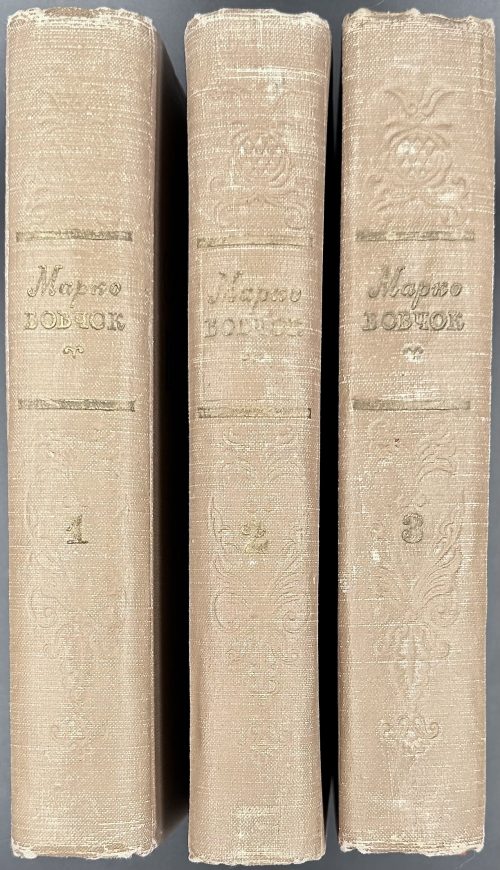 Three 8vo volumes, 20.8 x 13.8 cm each, uniformly bound in brown cloth with gilt lettering and embossed design to front and spine; v. 1: [1-4] 5-537 [3], total 540 pages plus frontispiece, two-colour woodcut portrait, by Ivan Nikolaevtsev; v. 2: [1-6] 7-537 [3], total 540 pages; v. 3: [1-6] 7-620 [4], total 624 pages. Waterstain throughout the third volume. Title-page (red and black): Марко Вовчок | СОБРАНИЕ СОЧИНЕНИЙ | ТОМ ПЕРВЫЙ (ВТОРОЙ, ТРЕТИЙ) | {fleuron} | ИЗДАТЕЛЬСТВО «ИЗВЕСТИЯ» | Москва | 1957 || Opposite t.p. (red and black): Марко Вовчок | СОБРАНИЕ СОЧИНЕНИЙ | В ТРЕХ | ТОМАХ | {fleuron} | ИЗДАТЕЛЬСТВО «ИЗВЕСТИЯ» | Москва | 1957 || Half-title (red and black): БИБЛИОТЕКА КЛАССИКОВ | ЛИТЕРАТУР | НАРОДОВ СССР | | {fleuron} || Imprint: Вступительная статья А. Белецкого. Подготовка текста и примечания С. Машинского. Print run: 30,000 copies. Contributors: Марко Вовчок [Marko Vovchok; Марія Олександрівна Вілінська] (Ukrainian, 1833 – 1907) – author. Other variants: Markowovzok and Marko Vovtchok. Олександр Іванович Білецький [Александр Иванович Белецкий] (Ukrainian, 1884 – 1961) – author/preface. Семен Иосифович Машинский (Ukrainian, 1914-1978) – author/editing and comments. Иван Григорьевич Николаевцев (Ukrainian, 1902–1960) – artist.
Three 8vo volumes, 20.8 x 13.8 cm each, uniformly bound in brown cloth with gilt lettering and embossed design to front and spine; v. 1: [1-4] 5-537 [3], total 540 pages plus frontispiece, two-colour woodcut portrait, by Ivan Nikolaevtsev; v. 2: [1-6] 7-537 [3], total 540 pages; v. 3: [1-6] 7-620 [4], total 624 pages. Waterstain throughout the third volume. Title-page (red and black): Марко Вовчок | СОБРАНИЕ СОЧИНЕНИЙ | ТОМ ПЕРВЫЙ (ВТОРОЙ, ТРЕТИЙ) | {fleuron} | ИЗДАТЕЛЬСТВО «ИЗВЕСТИЯ» | Москва | 1957 || Opposite t.p. (red and black): Марко Вовчок | СОБРАНИЕ СОЧИНЕНИЙ | В ТРЕХ | ТОМАХ | {fleuron} | ИЗДАТЕЛЬСТВО «ИЗВЕСТИЯ» | Москва | 1957 || Half-title (red and black): БИБЛИОТЕКА КЛАССИКОВ | ЛИТЕРАТУР | НАРОДОВ СССР | | {fleuron} || Imprint: Вступительная статья А. Белецкого. Подготовка текста и примечания С. Машинского. Print run: 30,000 copies. Contributors: Марко Вовчок [Marko Vovchok; Марія Олександрівна Вілінська] (Ukrainian, 1833 – 1907) – author. Other variants: Markowovzok and Marko Vovtchok. Олександр Іванович Білецький [Александр Иванович Белецкий] (Ukrainian, 1884 – 1961) – author/preface. Семен Иосифович Машинский (Ukrainian, 1914-1978) – author/editing and comments. Иван Григорьевич Николаевцев (Ukrainian, 1902–1960) – artist. -
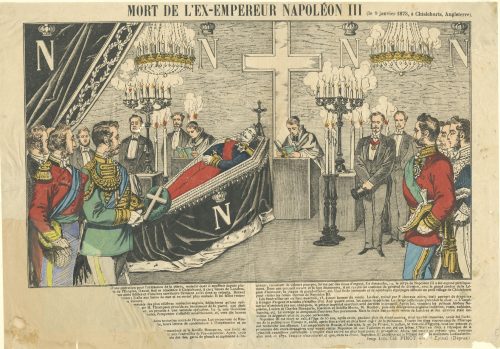 Hand-coloured woodcut on wove paper, 270 x 380 mm; attached to the sheet 303 x 442 mm with pencil ms inscription to the top left corner on the reverse: “Haye le 2-3-75”. Top: "MORT DE L'EX-EMPEREUR NAPOLÉON III (le 9 janvier 1873, à Chislehurts [sic], Angleterre)." Bottom right: "Imp. Lith. CH. PINOT, éditeur. Épinal (Dépose)". Bottom left corner of the image sheet torn and manually restored. Text partially lost, starting with « d’une opération pour l’extraction de la pierre, maladie dont’ il souffrait depuis plu-… ». See Chislehurst. Charles-François Pinot (French, 1817 – 1879) – publisher/printer.
Hand-coloured woodcut on wove paper, 270 x 380 mm; attached to the sheet 303 x 442 mm with pencil ms inscription to the top left corner on the reverse: “Haye le 2-3-75”. Top: "MORT DE L'EX-EMPEREUR NAPOLÉON III (le 9 janvier 1873, à Chislehurts [sic], Angleterre)." Bottom right: "Imp. Lith. CH. PINOT, éditeur. Épinal (Dépose)". Bottom left corner of the image sheet torn and manually restored. Text partially lost, starting with « d’une opération pour l’extraction de la pierre, maladie dont’ il souffrait depuis plu-… ». See Chislehurst. Charles-François Pinot (French, 1817 – 1879) – publisher/printer. -
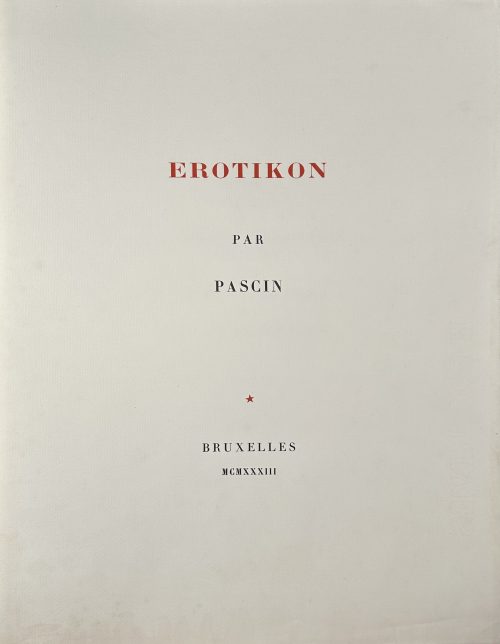 A portfolio of nine heliogravures after Jules Pascin. Cloth-backed cardboard portfolio 420 x 335 mm with 9 heliogravures on slightly tinted india paper, each numbered in pencil and mounted into a passe-partout 410 x 318 mm. Copy № 25 out of 40 printed on india (chine) paper. Copy № 25 of 40. Title (red and black): EROTIKON | PAR | PASCIN | ★ | BRUXELLES | MCMXXXIII || Limitation: CET | ALBUM | A ÉTÉ TIRÉ | A | QUARANTE ET UN EXEMPLAIRES | NUMÉROTÉS | DONT | UN EX. SUR PAPIER ANCIEN | & | QUARANTE EX. SUR CHINE | No (ms 25/40) || Catalogue raisonné: Dutel III № 1498. Seller's description:Neun Heliogravüren. 1933. Meist ca. 30 : 35 cm. Nummeriert. Exemplar 25/40 (Gesamtauflage 41). – Die Heliogravüren auf leicht getöntem China, jedes Blatt mit Bleistift nummeriert und in Passepartouts montiert. – Die neun Passepartouts eingelegt in zwei Büttenumschläge, einer mit Titel und dem nummerierten Auflagenvermerk, der zweite unbedruckt, ferner Büttenumschlag mit Titel in Rotdruck und Halbleinenchemise. – Die Heliogravüren erschienen 1933, drei Jahre nach Pascins Tod bei Daragnes in Paris mit der fingierten Angabe »Brüssel«. – Das berühmte Mappenwerk bildet eine der großen Seltenheiten der erotischen Kunst. Die Motive Pascins beschreibt das Bilderlexikon als »eine Art ›Boheme-Rokoko im Montmartre-Milieu‹« und lobt den Künstler: »Er ist ein außerordentlicher Zeichner, der es versteht, bei allem Zynismus, der seinen exhibitionistischen Charakter nicht verleugnet, auf diesem Kulturdünger eine neuartige Blume voll graziöser Schönheit erblühen zu lassen.« Mappe: 42 : 33,5 cm. – Der äußere Büttenumschlag mit leichtem Wasserrand. – Zwei Heliogravüren minimal stockfleckig, sonst tadellos und absolut vollständig. Dutel 1498 (mit Auflagenvarianten). – Der kalte Blick S. 198ff. – Bilderlexikon II, 718.
A portfolio of nine heliogravures after Jules Pascin. Cloth-backed cardboard portfolio 420 x 335 mm with 9 heliogravures on slightly tinted india paper, each numbered in pencil and mounted into a passe-partout 410 x 318 mm. Copy № 25 out of 40 printed on india (chine) paper. Copy № 25 of 40. Title (red and black): EROTIKON | PAR | PASCIN | ★ | BRUXELLES | MCMXXXIII || Limitation: CET | ALBUM | A ÉTÉ TIRÉ | A | QUARANTE ET UN EXEMPLAIRES | NUMÉROTÉS | DONT | UN EX. SUR PAPIER ANCIEN | & | QUARANTE EX. SUR CHINE | No (ms 25/40) || Catalogue raisonné: Dutel III № 1498. Seller's description:Neun Heliogravüren. 1933. Meist ca. 30 : 35 cm. Nummeriert. Exemplar 25/40 (Gesamtauflage 41). – Die Heliogravüren auf leicht getöntem China, jedes Blatt mit Bleistift nummeriert und in Passepartouts montiert. – Die neun Passepartouts eingelegt in zwei Büttenumschläge, einer mit Titel und dem nummerierten Auflagenvermerk, der zweite unbedruckt, ferner Büttenumschlag mit Titel in Rotdruck und Halbleinenchemise. – Die Heliogravüren erschienen 1933, drei Jahre nach Pascins Tod bei Daragnes in Paris mit der fingierten Angabe »Brüssel«. – Das berühmte Mappenwerk bildet eine der großen Seltenheiten der erotischen Kunst. Die Motive Pascins beschreibt das Bilderlexikon als »eine Art ›Boheme-Rokoko im Montmartre-Milieu‹« und lobt den Künstler: »Er ist ein außerordentlicher Zeichner, der es versteht, bei allem Zynismus, der seinen exhibitionistischen Charakter nicht verleugnet, auf diesem Kulturdünger eine neuartige Blume voll graziöser Schönheit erblühen zu lassen.« Mappe: 42 : 33,5 cm. – Der äußere Büttenumschlag mit leichtem Wasserrand. – Zwei Heliogravüren minimal stockfleckig, sonst tadellos und absolut vollständig. Dutel 1498 (mit Auflagenvarianten). – Der kalte Blick S. 198ff. – Bilderlexikon II, 718. -
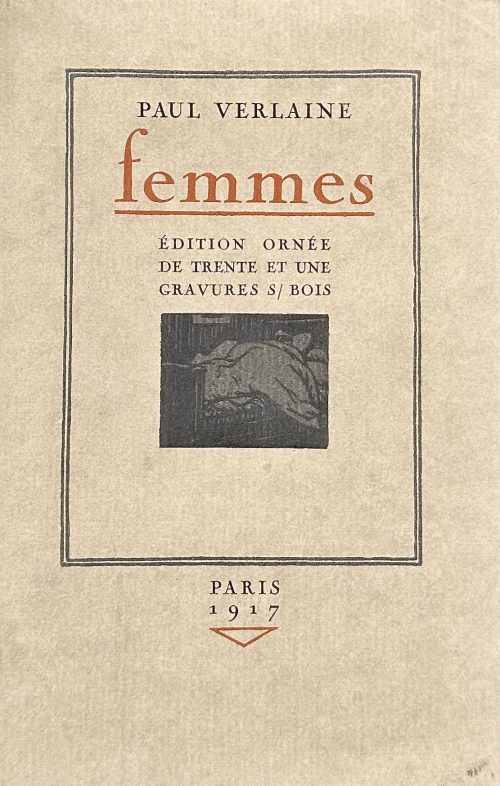 Softcover, 258 x 166 mm, publisher’s olive French flapped wrappers in owner’s glassine dustcover, edges untrimmed, some pages uncut, printed on thick wove paper with watermark “Hollande van Gelder Zonen”, in a slipcase. Pp.: [1-10] 11-129 [5], pages in wrappers included in the count, total 67 leaves; two-tone woodcuts by Jean-Gabriel Daragnès within the pagination. Title-page (red and black, in a double-fillet frame): PAUL VERLAINE | femmes | ÉDITION ORNÉE | DE TRENTE ET UNE | GRAVURES S/ BOIS | {vignette} | (under the bottom frame) PARIS | 1917 | {red triangle} || Limitation: Il a été tiré de cet ouvrage : 11 15 Exemplaires sur vieux papier de Japon numérotés de I à XV; 15 20 Exemplaires sur papier de Chine numérotés de XVI à XXXV; auxquels on a joint une suite des fumés sur même papier. 250 Exemplaires sur papier vélin de Hollande Van Gelder Zonen numérotés de 1 à 250. Après le tirage les bois ont été détruits. № 1. Numbers “15” and “20” corrected manually by Daragnès (per Dutel). This is copy № of vélin de Hollande print run. Catalogue raisonné: Dutel II: № 295; Nordmann II № 544. Seller’s description: Un volume broché in-8° sous couverture illustrée et rempliée. Etui cartonné. Illustré de 31 gravures sur bois en camaïeu, attribuées à DARAGNES, la plupart très libres, dont 18 à pleine page. Tiré à [226 ou 285] ex. numérotés. 1 des [200 ou 250] sur Hollande Van Gelder Zonen. Le nôtre porte le n°1. (Dutel : 295. Pia : 501. Carteret : IV, 392 : Belle édition rare, très estimée ». Monod : 11086). Dorgelès commenta ainsi ces illustrations : « Dans ces nus voluptueux et tragiques, qui semblent à la fois s’aimer et se haïr, on retrouve la même frénésie amère qui tourmente les poèmes interdits de Verlaine » (in Catalogue de livres... Daragnès, Drouot 1924, n°55). Très rares rousseurs. TRES BON EXEMPLAIRE, toujours recherché. Contributors: Paul Verlaine (French, 1844 – 1896) – author. Jean-Gabriel Daragnès (French, 1886 – 1950) – artist/publisher.
Softcover, 258 x 166 mm, publisher’s olive French flapped wrappers in owner’s glassine dustcover, edges untrimmed, some pages uncut, printed on thick wove paper with watermark “Hollande van Gelder Zonen”, in a slipcase. Pp.: [1-10] 11-129 [5], pages in wrappers included in the count, total 67 leaves; two-tone woodcuts by Jean-Gabriel Daragnès within the pagination. Title-page (red and black, in a double-fillet frame): PAUL VERLAINE | femmes | ÉDITION ORNÉE | DE TRENTE ET UNE | GRAVURES S/ BOIS | {vignette} | (under the bottom frame) PARIS | 1917 | {red triangle} || Limitation: Il a été tiré de cet ouvrage : 11 15 Exemplaires sur vieux papier de Japon numérotés de I à XV; 15 20 Exemplaires sur papier de Chine numérotés de XVI à XXXV; auxquels on a joint une suite des fumés sur même papier. 250 Exemplaires sur papier vélin de Hollande Van Gelder Zonen numérotés de 1 à 250. Après le tirage les bois ont été détruits. № 1. Numbers “15” and “20” corrected manually by Daragnès (per Dutel). This is copy № of vélin de Hollande print run. Catalogue raisonné: Dutel II: № 295; Nordmann II № 544. Seller’s description: Un volume broché in-8° sous couverture illustrée et rempliée. Etui cartonné. Illustré de 31 gravures sur bois en camaïeu, attribuées à DARAGNES, la plupart très libres, dont 18 à pleine page. Tiré à [226 ou 285] ex. numérotés. 1 des [200 ou 250] sur Hollande Van Gelder Zonen. Le nôtre porte le n°1. (Dutel : 295. Pia : 501. Carteret : IV, 392 : Belle édition rare, très estimée ». Monod : 11086). Dorgelès commenta ainsi ces illustrations : « Dans ces nus voluptueux et tragiques, qui semblent à la fois s’aimer et se haïr, on retrouve la même frénésie amère qui tourmente les poèmes interdits de Verlaine » (in Catalogue de livres... Daragnès, Drouot 1924, n°55). Très rares rousseurs. TRES BON EXEMPLAIRE, toujours recherché. Contributors: Paul Verlaine (French, 1844 – 1896) – author. Jean-Gabriel Daragnès (French, 1886 – 1950) – artist/publisher. -
 Iron tsuba of round form profusely decorated with brass inlay of plants, birds, well, and family crests (mon) in suemon-zōgan technique and occasional brass dots (nail-heads) or ten-zōgan. Seppa-dai and kozuka-hitsu-ana outlined with brass inaly, possibly repaired: rope-shaped wire here and there replaced with flat wire. The plate is very thin, with remnants of lacquer. Ōnin school. Size: 75.8 x 75.2 x 2.3 mm. Weight: 77.5 g. On the front side (omote) motif includes the following elements (from 12 o'clock, clockwise):
Iron tsuba of round form profusely decorated with brass inlay of plants, birds, well, and family crests (mon) in suemon-zōgan technique and occasional brass dots (nail-heads) or ten-zōgan. Seppa-dai and kozuka-hitsu-ana outlined with brass inaly, possibly repaired: rope-shaped wire here and there replaced with flat wire. The plate is very thin, with remnants of lacquer. Ōnin school. Size: 75.8 x 75.2 x 2.3 mm. Weight: 77.5 g. On the front side (omote) motif includes the following elements (from 12 o'clock, clockwise):- Water plantain (a.k.a. arrowhead, or omodaka): "a perpetual plant of the water plantain family, was also called shōgunsō (victorious army grass). Because of this martial connotation, it was a design favored for the crests of samurai families" [see: Family Crests of Japan. // Stone Bridge Press, Berkeley, CA, 2007; p. 63].
- Heron (sagi): "...considered an emblem of longevity, and from China comes the practice of regarding the bird as a mount of the gods and the Taoist sennin. [...] heron also reflects an inauspicious connotation, for the word sagi is homophone for 'fraud' and 'false pretenses'." [see: Merrily Baird. Symbols of Japan. Thematic motifs in art and design. // Rizzoli international publications, Inc., 2001; p. 112]. Some may say, that this is not a heron but a crane (tsuru). It's very possible, and in this case the negative connotation is lost, but the reference to longevity and allusion to sennin remain.
- Pampas grass (susuki, or obana): as per Merrily Baird, p. 95 and John W. Dower, p. 66, pampas grass is one of the Seven Grasses of Autumn. When combined with flying wild gees, conveys strong autumnal mood.
- Plum blossom (ume): according to Merrily Baird, the flower has a vast variety of symbolic meanings, including longevity, and a reference to the Chinese Taoists. It is used in 80 family crests [see: Japanese Design Motifs: 4,260 Illustrations of Japanese Crests; Compiled by the Matsuya Piece-Goods Store; Translated by Fumie Adachi. // Dover Publications, Inc., 1972.] Plum is "celebrated for its sweet perfume, delicate blossoms, and habit of blooming at the end of winter".
- Tree flying wild geese (kari): "Wild geese arrive in large flocks in southern regions during the autumn months, and following their migratory instincts, head back north in spring" [Family Crests of Japan, pp. 85-86]. "The importance of geese in Japanese art was further secured by stories of several military heroes who had achieved victory in battle when a sudden breaking of ranks by flying geese signaled an ambush. The protective role of the birds led to their frequent use in decorating sword furnishings and possibly also their adoption as a family crest motif.Finally, the goose in Asia plays a role in religious traditions" [Merrily Baird, pp.111-112].
- Hikiryō (line, or bar, or stripe) - a symbol which consists of one, two, or three horizontal or vertical stripes in a circle. "In wartime, Japanese generals [...] surrounded their encampments with huge cloth curtains. Usually these were made of cloth sewn together horizontally and varying in color [...] to distinguish the individual general and his followers. The stripe thus assumed strong martial connotations, and became a mark of identification on personal military gear as well. In the early fourteenth century the heads of the Ashikaga and Nitta, then the two most powerful clans in Japan, both adopted stripe patterns as a family crest". [See: Family Crests of Japan, p. 111 and John W. Dower. The elements of Japanese design - A handbook of family crests, heraldry & symbolism. // Weatherhill, New York, Tokyo, 1985, p. 144].
- Hikiryō, see above.
- Pampas grass (susuki, or obana), see above.
- Bellflower (kikyo): One of the Seven Grasses of Autumn. "As a crest, it have been adopted among the warriors around the thirteenth century, primarily because of it's beauty" [John W. Dower, p. 48].
- Four flying wild geese (kari), see above.
- Weeping willow (yanagi): "It is commonly represented with water, snow, swallows, or herons. A branch of willow (yoshi) is one of the attributes of the Buddhist deity Senju Kannon (Thousand-Armed Kannon), who is said to use the branch to sprinkle the nectar of life contained in a vase. [Merrily Baird, pp. 66-67].
- Lone plum blossom in a well frame/crib (igeta, izitsu): "Well crib was one of the most popular motifs in Japanese heraldry". As a crest it may stay simply for the first character (i) of the family name, however, with a flower inside the well frame, and together with the other symbols present, it may aggravate the sense of autumn-ness. The ten-zōgan dots in this particular case may represent the snowflakes or autumn stars.
-
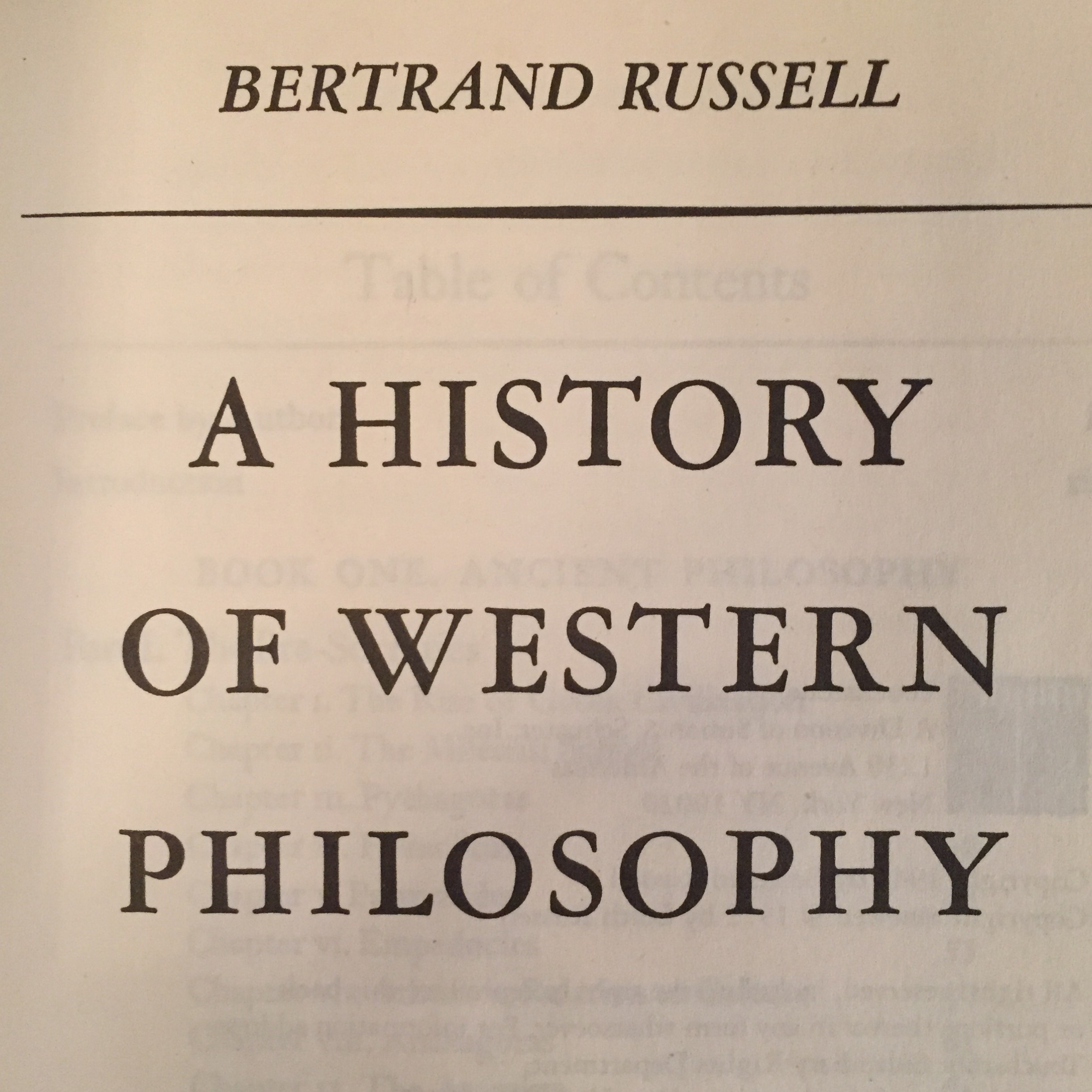
Bertrand Russell. A history of western philosophy. A Touchstone Book. Published by Symon & Schuster, 2007. [Reprint 1945].
ISBN-10: 1-4165-5477-7
ISBN-13: 978-4165-5477-6.
-
 Bando Mitsugorō III as Lady Iwafuji and Nakamura Matsue III as Lady Onoe, 1821.「局岩ふじ 坂東三津五郎」(三代)、「中老尾上 中村松江」(三代) in kabuki play Kagamiyama Kokyô no Nishikie [鏡山旧錦繪] (Mirror mountain: A women’s treasury of loyalty); author: Yô Yôdai. Artist: Shunkōsai Hokushū (春好斎 北洲), who is also known as Shunkō IV, active from about 1802 to 1832. Actors: Bandō Mitsugorō III [三代目 坂東 三津五郎] (Japanese, 1775 – 1831); other names: Bandō Minosuke I, Morita Kanjirô II, Bandō Mitahachi I, Bandō Minosuke I, Bandō Mitahachi I. Nakamura Matsue III [三代目中村松江] (Japanese, 1786-1855); other names: Nakamura Sankō I, Nakamura Tomijūrō II, Ichikawa Kumatarō. Year: 1821 (Bunsei 4), 1st month. Publisher: Wataya Kihei (Wataki) (Japanese, fl. c. 1809 – 1885) Signed Shunkôsai Hokushû ga 春好斎北洲画. MFA Accession № 11.35375. MFA description: "Play: Keisei Kagamiyama (Mirror Mountain, a Courtesan Play). Theatre: Kado けいせい双鏡山(けいせいかがみやま)角. Ref.: [LIB-1193.2013] Leiter. Kabuki Encyclopedia, p. 156; [LIB-0879-2.2015] Kabuki plays on stage (vol. 2): 1773-1799, pp. 172-212.
Bando Mitsugorō III as Lady Iwafuji and Nakamura Matsue III as Lady Onoe, 1821.「局岩ふじ 坂東三津五郎」(三代)、「中老尾上 中村松江」(三代) in kabuki play Kagamiyama Kokyô no Nishikie [鏡山旧錦繪] (Mirror mountain: A women’s treasury of loyalty); author: Yô Yôdai. Artist: Shunkōsai Hokushū (春好斎 北洲), who is also known as Shunkō IV, active from about 1802 to 1832. Actors: Bandō Mitsugorō III [三代目 坂東 三津五郎] (Japanese, 1775 – 1831); other names: Bandō Minosuke I, Morita Kanjirô II, Bandō Mitahachi I, Bandō Minosuke I, Bandō Mitahachi I. Nakamura Matsue III [三代目中村松江] (Japanese, 1786-1855); other names: Nakamura Sankō I, Nakamura Tomijūrō II, Ichikawa Kumatarō. Year: 1821 (Bunsei 4), 1st month. Publisher: Wataya Kihei (Wataki) (Japanese, fl. c. 1809 – 1885) Signed Shunkôsai Hokushû ga 春好斎北洲画. MFA Accession № 11.35375. MFA description: "Play: Keisei Kagamiyama (Mirror Mountain, a Courtesan Play). Theatre: Kado けいせい双鏡山(けいせいかがみやま)角. Ref.: [LIB-1193.2013] Leiter. Kabuki Encyclopedia, p. 156; [LIB-0879-2.2015] Kabuki plays on stage (vol. 2): 1773-1799, pp. 172-212. -
 Iron tsuba of round form with design of military commander's fan (gunbai) in openwork (sukashi). Square rim. Hitsu-ana plugged with lead or tin. Ko-tosho school. Mid Muromachi period. Late 15th century: Entoku era [1489-92] / Meio era [1489-1501]. Height: 80.3 mm, Width: 81.5 mm, Rim thickness: 3.0 mm. Centre thickness: 3.5 mm. Provenance: Sasano Masayuki Collection, №23 in Japanese Sword Guard Masterpieces from the Sasano Collection, 1994: Ko-tosho. Sukashi design: Military commander's fan (gunbai). Mid Muromachi period. Late 15th century (Entoku / Meio era). The military commander's fan (gunbai) was cherished by samurai warriors. This tsuba is relatively thick, with the large fan nicely positioned on the plate.
Iron tsuba of round form with design of military commander's fan (gunbai) in openwork (sukashi). Square rim. Hitsu-ana plugged with lead or tin. Ko-tosho school. Mid Muromachi period. Late 15th century: Entoku era [1489-92] / Meio era [1489-1501]. Height: 80.3 mm, Width: 81.5 mm, Rim thickness: 3.0 mm. Centre thickness: 3.5 mm. Provenance: Sasano Masayuki Collection, №23 in Japanese Sword Guard Masterpieces from the Sasano Collection, 1994: Ko-tosho. Sukashi design: Military commander's fan (gunbai). Mid Muromachi period. Late 15th century (Entoku / Meio era). The military commander's fan (gunbai) was cherished by samurai warriors. This tsuba is relatively thick, with the large fan nicely positioned on the plate. -
 Iron tsuba with design of a cricket and grass inlaid in brass (suemon-zōgan) and a bridge over a stream in openwork (sukashi) on both sides. Inlay of distant part of the cricket's antenna is missing. Heianjō School. Momoyama period. Diameter: 79.5 mm, thickness at seppa-dai: 3.3 mm NBTHK # 4002100.
Iron tsuba with design of a cricket and grass inlaid in brass (suemon-zōgan) and a bridge over a stream in openwork (sukashi) on both sides. Inlay of distant part of the cricket's antenna is missing. Heianjō School. Momoyama period. Diameter: 79.5 mm, thickness at seppa-dai: 3.3 mm NBTHK # 4002100. -
 An unsigned print, presumably by Katsukawa Shunshō that presumably depicts a kabuki actor Ichikawa Monnosuke II. I was not able to find any reference of the image. Size: Hosoban. According to The actor's image. Print makers of the Katsukawa School. Timothy T. Clark and Osamu Ueda with Donald Jenkins. Naomi Noble Richard, editor The Art Institute of Chicago in association with Princeton University Press, 1994, Ichikawa Monnosuke II was born in 1743, in Ōji Takinogawa, Edo. He died on October 19, 1974. His specialities were young male roles (wakashu) and male leads (tachi yaku). He was considered to be one of the four best young actors of his day.
An unsigned print, presumably by Katsukawa Shunshō that presumably depicts a kabuki actor Ichikawa Monnosuke II. I was not able to find any reference of the image. Size: Hosoban. According to The actor's image. Print makers of the Katsukawa School. Timothy T. Clark and Osamu Ueda with Donald Jenkins. Naomi Noble Richard, editor The Art Institute of Chicago in association with Princeton University Press, 1994, Ichikawa Monnosuke II was born in 1743, in Ōji Takinogawa, Edo. He died on October 19, 1974. His specialities were young male roles (wakashu) and male leads (tachi yaku). He was considered to be one of the four best young actors of his day. -
 Iron tsuba of round form with slanting rays of light (shakoh) Christian motif (Jesuit's IHS symbol) in openwork (sukashi). Traditional description of this kind of design is called "tokei", or "clock gear". Edo period.
Iron tsuba of round form with slanting rays of light (shakoh) Christian motif (Jesuit's IHS symbol) in openwork (sukashi). Traditional description of this kind of design is called "tokei", or "clock gear". Edo period.Size: 77.7 x 76.1 x 6.7 mm.
For information regarding shakoh tsuba see article 'Kirishitan Ikenie Tsuba" by Fred Geyer at Kokusai Tosogu Kai; The 2nd International Convention & Exhibition, October 18-23, 2006, pp. 84-91. -
 Woman Looking out a Round Window at a Woman with a Komusō Hat.
Woman Looking out a Round Window at a Woman with a Komusō Hat.Artist Koikawa Harumasa (a.k.a. Banki): fl. 1801–18. Wikipedia: Koikawa Harumasa (恋川 春政; active 1800–1820), later called Banki Harumasa (晩器 春政). Associated with Katsukawa school.
Signed: Banki ga (on the bamboo flower container in the background). Censor's seal: kiwame. Mark of unidentified publisher, Genshoku #1017; Marks U084 Ibiko, p. 387.
References:
Jacob Pins #828.
-

Thin iron plate of round form and black color carved in sukidashi-bori with design of rocks, waves, clouds, temple gates (torii), mountain pavilion and 5-storey pagoda on both sides, alluding to Todai-ji temple in Nara. Hitsu-ana pierced later. Very narrow very slightly raised rim. Copper sekigane.
Late Muromachi period, 16th century. Dimensions: 88.7 x 88.0 x 2.4 mm (seppa-dai), 1.8 mm (base plate).Reference: “Art of the Samurai” on page 232, №140: ”Kamakura tsuba with Sangatsu-do tower and bridge. Muromachi period, 16th century. 83 mm x 80 mm. Unsigned. Tokyo National Museum. The mountain pavilion and bridge carved in sunken relief on the iron tsuba – both part of Tōdai-ji, a temple in Nara – are detailed in fine kebori (line) engraving. As a result of the chiseling used to create the relief, the ground of the piece is relatively thin".
-
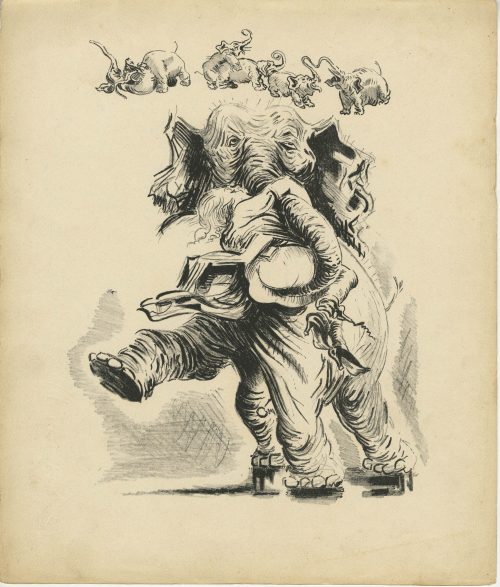
Album of 20 hand-coloured lithographs with a title page and a 'justification du tirage' page in an original snakeskin-clothed cardboard binder. Drawn on stone by Anonymous, attributed to Santippa. The theme of these pictures can be described as erotic humour.
Edition: 200 copies printed in Bruxelles, c. 1938; this copy without a number.
Watermarked wove paper: Word "Marais" and a flower.
Dimensions: 24.3 x 29.3 cm According to J.-P. Dutel, the author of these images is Georges Hoffmann under the pseudonym Santippa. Honesterotica provides a different name: Gaston Hoffmann [Santippa] (French, 1883 – 1977), which seems adequate. Catalogue raisonné: Dutel (1920-70): 2496. -
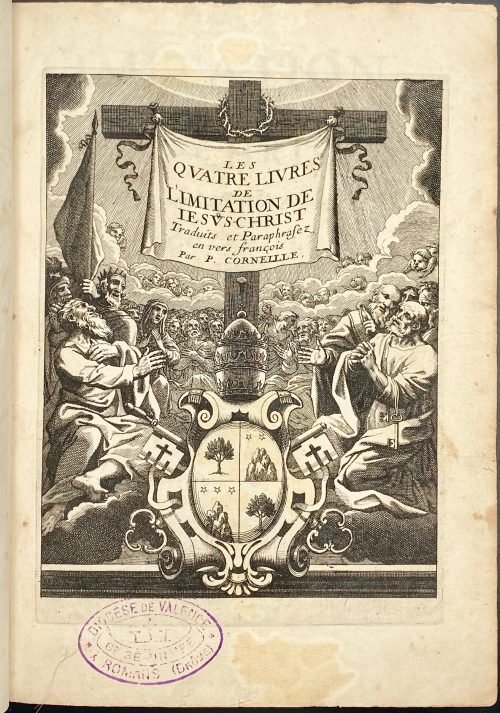 L'Imitation de Jésus-Christ / Traduite et paraphrasée en Vers François Par P. Corneille. — A Paris, Chez Pierre Rocolet, Imprimeur & Libraire ordinaire du Roy, au Palais, en la Gallerie des Prisonniers, aux Armes du Roy & de la Ville. M. DC. LVI. Avec Approbation des Docteurs, et Privelege de sa Majesté. Paris: Pierre Rocolet, 1656. Half-title: Les Quatre Livres de L'Imitation de Iesus-Christ. Traduites et paraphrasez en vers françois Par P. Corneille. — pp.: ff [2 pictorial ht, verso blank] [2 title, blank] [10 epistre] [2 av lecteur] [2 approbation, frontis.] 1-551 [552-60 table, privilege] bf. 8vo, 24.7 x 18.7 cm, hardcover; full speckled brown calf, gilt double-ruled boards, spine with raised bands, gilt double-ruled compartments with lozenges, sprayed margins; pages darkened. Purple ink stamp of Diocèse de Valencia to half-title. Nut ink ex libris handwriting on front paste-down. Plates: Half-title: unsigned copper engraving with the coat of arms of Pope Alexander VII (r. 1655 – 1667) which contains an oak tree in the top left and bottom right quarters (from Della Rovere family, Dukes of Urbino), the top right and bottom left quarters feature a mountain of six coupeaux in base with three stars above (from Chigi family). Four copper engravings inbound at the beginning of each book signed 'F. Chauueau in et fe.': Page 1: Jesus teaches His disciple. Page 113: Annunciation. Page 183: Jesus meets Simon called Peter and his brother Andrew. Page 459: Last Supper. François Chauveau (10 May 1613, Paris – 3 February 1676, Paris), a French painter and engraver. Thomas à Kempis (c. 1380 – 25 July 1471), a German-Dutch canon regular. Pierre Corneille (1606 – 1684), a French poet and playwright. Pierre Rocolet (1610 – 1662, active circa 1638 à 1662), a French publisher and printer.
L'Imitation de Jésus-Christ / Traduite et paraphrasée en Vers François Par P. Corneille. — A Paris, Chez Pierre Rocolet, Imprimeur & Libraire ordinaire du Roy, au Palais, en la Gallerie des Prisonniers, aux Armes du Roy & de la Ville. M. DC. LVI. Avec Approbation des Docteurs, et Privelege de sa Majesté. Paris: Pierre Rocolet, 1656. Half-title: Les Quatre Livres de L'Imitation de Iesus-Christ. Traduites et paraphrasez en vers françois Par P. Corneille. — pp.: ff [2 pictorial ht, verso blank] [2 title, blank] [10 epistre] [2 av lecteur] [2 approbation, frontis.] 1-551 [552-60 table, privilege] bf. 8vo, 24.7 x 18.7 cm, hardcover; full speckled brown calf, gilt double-ruled boards, spine with raised bands, gilt double-ruled compartments with lozenges, sprayed margins; pages darkened. Purple ink stamp of Diocèse de Valencia to half-title. Nut ink ex libris handwriting on front paste-down. Plates: Half-title: unsigned copper engraving with the coat of arms of Pope Alexander VII (r. 1655 – 1667) which contains an oak tree in the top left and bottom right quarters (from Della Rovere family, Dukes of Urbino), the top right and bottom left quarters feature a mountain of six coupeaux in base with three stars above (from Chigi family). Four copper engravings inbound at the beginning of each book signed 'F. Chauueau in et fe.': Page 1: Jesus teaches His disciple. Page 113: Annunciation. Page 183: Jesus meets Simon called Peter and his brother Andrew. Page 459: Last Supper. François Chauveau (10 May 1613, Paris – 3 February 1676, Paris), a French painter and engraver. Thomas à Kempis (c. 1380 – 25 July 1471), a German-Dutch canon regular. Pierre Corneille (1606 – 1684), a French poet and playwright. Pierre Rocolet (1610 – 1662, active circa 1638 à 1662), a French publisher and printer. -
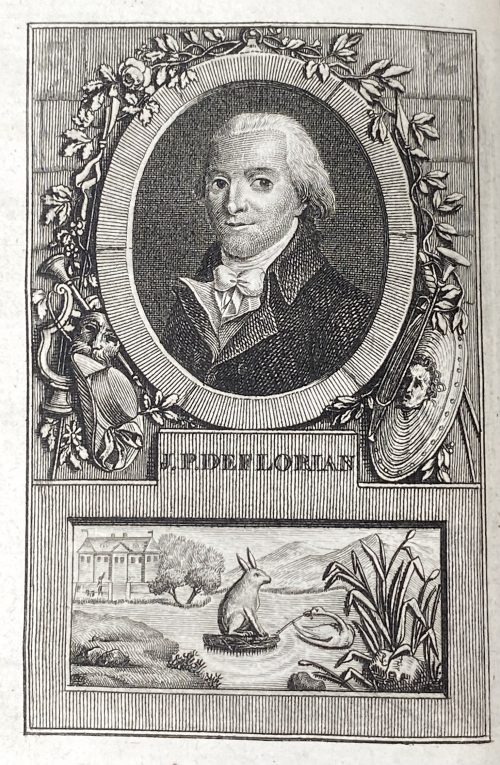 Title: FABLES | DE | M. DE FLORIAN , | de l’académie françoise, de celles de Madrid , | Florence, etc. | — | Je tâche d'y tourner le vice ridicule , | Ne pouvant l'attaquer avec des bras d'Hercule. | La Font. Fables , liv. V , I. — | [publisher's device ] | A PARIS, | DE L'IMPRIMERIE DE P. DIDOT L'AINÉ, | 1792. Pagination: ffl, [2 - h.t. / Imp.] [2 - blank / frontis.] [2 - tp. / blank] [5] 6-224 [2 - advert. / blank], bfl. Collation: numbered 1(5), 2-18(6), 19(3); engarved frontispiece portrait of Florian after François Hüet-Villiers, 5 engraved plates by Longueil, Delignon, and Gaucher after Flouest. Binding: Contemporary full mottled calf, all margins red, gilt floral ornaments to flat spine, red label with gilt lettering. Catalogue raisonné: Cohen, de Ricci 1912: p. 398-9.
Title: FABLES | DE | M. DE FLORIAN , | de l’académie françoise, de celles de Madrid , | Florence, etc. | — | Je tâche d'y tourner le vice ridicule , | Ne pouvant l'attaquer avec des bras d'Hercule. | La Font. Fables , liv. V , I. — | [publisher's device ] | A PARIS, | DE L'IMPRIMERIE DE P. DIDOT L'AINÉ, | 1792. Pagination: ffl, [2 - h.t. / Imp.] [2 - blank / frontis.] [2 - tp. / blank] [5] 6-224 [2 - advert. / blank], bfl. Collation: numbered 1(5), 2-18(6), 19(3); engarved frontispiece portrait of Florian after François Hüet-Villiers, 5 engraved plates by Longueil, Delignon, and Gaucher after Flouest. Binding: Contemporary full mottled calf, all margins red, gilt floral ornaments to flat spine, red label with gilt lettering. Catalogue raisonné: Cohen, de Ricci 1912: p. 398-9.






